Action for Primates
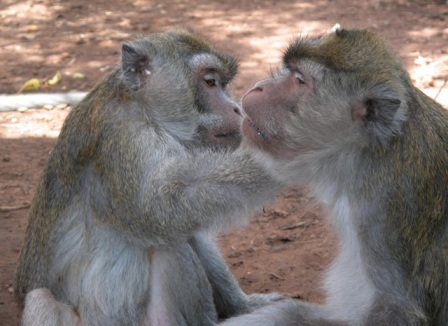
|
Action for Primates |

|
|
The following are take action items we have posted in 2021. See elsewhere for take action alerts from other years. In addition to the Take Action entries below, you can click here for petitions you can sign and share to help non-human primates around the world.
Index of action alerts; select date & title to access:
15 December 2021: Concern for hundreds of monkeys transported to the USA for research

Action for Primates has alerted the US authorities to our concerns for the welfare of hundreds of monkeys who are being transported by air from Cambodia to the US. A concerned individual at Nairobi airport has informed us that Vision Air, a Karachi-based airline, flew 720 monkeys as cargo on a circuitous route from Cambodia to Nairobi with stopovers in Delhi, Karachi and Muscat, before landing in Nairobi. After 10 hours on the ground in Nairobi, the monkeys were flown to JFK in New York on a Kenya Airways aircraft.
This will have been an arduous ordeal for these 720 monkeys. The trauma and stress these intelligent and sentient beings will have experienced is unimaginable, having had to endure many hours of confinement and completely unnatural conditions. We estimate that on arrival at JFK, the monkeys will have been confined in crates for over 43 hours (almost 28 hours in flight and 16 hours on the ground in transit). This total, however, does not include the many additional hours these monkeys were held in crates on the journey to and at the airport in Cambodia, and will have to endure during the journey by road from JFK to the final destination, Charles River Laboratories in Maryland, a large US importer and user of non-human primates in research and testing.
The long-tailed macaque is the most heavily traded non-human primate species for the global research and toxicity (poisoning) testing industry, with the US being one of the world's largest importers and users of non-human primates. In 2020, imports of long-tailed macaques from Cambodia by the US increased by 82.8% – from 8,571 in 2019 to 15,664 in 2020.
During transportation, monkeys are held in small transit crates and travel as cargo. In addition to the cramped conditions, they may be forced to endure inadequate ventilation, unfamiliar and loud noises, temperature and humidity fluctuations and delays en-route. Statistics for primate deaths and illnesses either during transportation or subsequently are generally not publicised. On 15th November 2021, several monkeys were found dead on board a Wamos Air flight from Cambodia to Houston, Texas.
Kenya Airways is on record as being committed to protecting wildlife
and aims to preserve and protect the most endangered animals
(https://travelradar.aero/kenya-airways-protection-of-wildlife/). All non-human primates are considered either on the verge of extinction or vulnerable to human-instigated pressures that may soon drive them to extinction. It seems hypocritical for Kenya Airways to claim a concern for wildlife, yet be responsible for shipping hundreds or thousands to suffer and die in laboratories.
These flights of misery must stop! Please speak up for these – and future – monkeys by joining Action for Primates and One Voice in urging Vision Air and Kenya Airways to stop transporting monkeys destined for research and toxicity testing (clicking on each E-mail address will create a sample message you can edit as desired before sending):
6 December 2021: Take action against the cruel Mauritius trade in monkeys for research

|
Action for Primates is joining other animal protection groups across Europe in a Week of Action against the trade in long-tailed macaques for research from Mauritius. During 6th-11th December, more than a dozen European animal groups are raising awareness by holding events and taking part in a social media campaign that will focus attention on the Mauritius government, embassies and tourism offices across Europe, calling for an end to the Mauritius trade in monkeys for research.
Below, you will find numerous actions you can take to help the monkeys from Mauritius. Please try to do all and ask others to join in this important campaign.
Mauritius, famous for its beaches, tropical climate, heritage sites and wildlife, is a popular destination for European holidaymakers. The country's promotion as a "paradise island", however, is tarnished by a dark side of which most holidaymakers are totally unaware: the country's cruel persecution of the wild monkeys who share the island with the human residents.
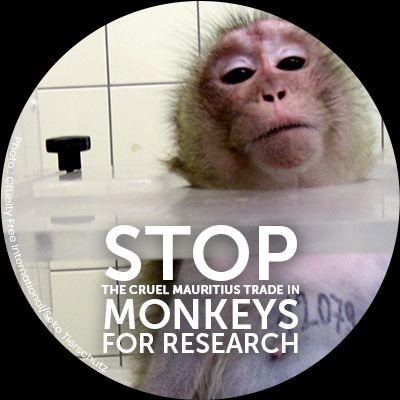
Mauritius is one of the world's largest exporters of long-tailed macaques for the global research and toxicity testing industry and the main supplier to Europe, exporting thousands every year. There has been a significant increase in the number of monkeys exported during 2021. Between January and September, 10,810 individuals were sent overseas to laboratories, including 1,913 (Spain), 758 (France), 642 (UK), 109 (Netherlands), 112 (Canada) and 7,276 (USA). This represents an increase of over 58% for the same period during 2020. Supply companies – Camarney SL in Spain and Silabe (Simian Laboratory Europe) in France – are known to regularly import many of these monkeys for breeding or for sale to laboratories in Europe.
The monkeys are packed into small transit crates and transported from Mauritius as cargo by air. Air France is the main airline known to be involved in transporting monkeys from Mauritius to Europe. Other airlines that fly monkeys out of Mauritius to other destinations include Safe Air (Kenya-based) and Wamos Air (Spanish-based).
How to support the Week of Action:
29 November 2021: Rhesus monkeys forced to become cocaine addicts in inhumane publicly funded research in US
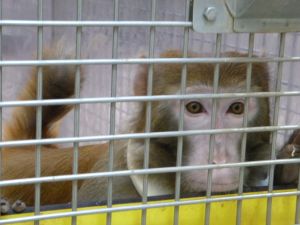
Rhesus macaques were forced to become cocaine addicts for a year and then subjected to two years of forced withdrawal, while changes in the brain were analysed in an attempt to understand what happens to people. This research was done at the University of Pittsburgh (1). It was approved by the Institutional Animal Care and Use Committee at the University of Pittsburgh
and funded entirely with public funds through the National Institutes of Health. According to the NIH RePORTER, the researchers have already been awarded almost $2 million US for this project.
Fourteen adult male rhesus macaques were trained
to perform several menial tasks on a touch screen monitor. The macaques were deprived of water to the extent that the researchers could use water as a reward
. During the experiment, they were only allowed 25 mL/kg/day
. This would only be about 175 mL (less than six ounces) for the entire day for a seven kg macaque, which is the average weight of an adult male.
The macaques were also subjected to surgery to implant a device in their backs so that cocaine could be injected directly into the bloodstream. Eight of the macaques were coerced into self-administering cocaine, the maximum daily allocations of six infusions (about 21 mg per day) during four sessions per week, each lasting as much as two hours. This went on for one year, or as the researchers called it, chronic cocaine…self-administration
. Their cocaine was then withheld, and they were forced to undergo two years of forced abstinence. The macaques used as the control
animals had to perform the same tasks in order to receive the water reward
.
The macaques were subjected to episodes of anaesthesia in order to perform magnetic resonance imaging at different times before and during the experiment. There was no account of the effect the cocaine had on the macaques or the impact following its withdrawal nor how the monkeys were housed during the two years of forced abstinence. Nor did the researchers state what the fate of the monkeys was at the end of the experiment. The approach and write-up of this experiment was mechanical and devoid of any humanity with respect to what these sentient and intelligent beings were subjected.
In people, it has been reported that cocaine produces a sense of euphoria. A 'crash' follows almost immediately once cocaine is stopped. Users suffer a strong craving, as well as fatigue, anxiety, sleepiness, and sometimes agitation. Craving and depression can last for months. There is no reason to doubt that the macaques must have suffered similarly, made much worse by their imprisonment in single metal caging (we suspect, as this is the norm) and a lack of understanding as to what was happening to them.
Although the authors found 'changes' in the macaques, more importantly, they cited many studies on the effects of cocaine on the brain and cognition of people. Substance abuse is a human disease and is far more complex than simply taking drugs. It is reprehensible that non-human primates – who cannot give their consent and are unquestionably unwilling – continue to be manipulated and made to suffer in this kind of 'research'. Human variables such as genetics, emotional and personal experiences, and socioeconomic aspects, can never be simulated or resolved through non-human primate research. The millions of tax dollars spent each year on 'animal models' of drug addiction could be better used to directly help the millions of people who suffer from substance abuse.
Please speak out on behalf of these eighteen rhesus macaques, by letting the responsible people know that such research is not only morally reprehensible, but also fiscally irresponsible:
Reference:
24 November 2021: Hundreds of monkeys flown to Europe by Volga-Dnepr Airlines
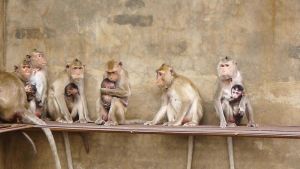
Animal Rights has received evidence that a Volga-Dnepr Airlines cargo flight landed in Brussels Zaventem on Monday (22 Nov 2021) with 356 monkeys on board. The 356 monkeys were confined in 77 crates and flown as cargo on Flight VDA5438 from Ho Chi Minh in Vietnam to Brussels with a stopover in Barnaul in Siberia. The cargo of monkeys was handled by Aviapartner Holding NV, a cargo handling company, and inspected by the Animal Care & Inspection Center upon arrival in Zaventem. Vietnam and Mauritius are the two main exporters of monkeys to European laboratories.
Action for Primates is working with Animal Rights in their efforts to find out the final destination for these monkeys, such as a testing laboratory or a breeding facility supplying monkeys for research. The organisations are also campaigning via social media, calling on the public to send messages of concern and objection to the parties involved.
The trauma and stress these intelligent and sentient beings must have experienced is unimaginable, having to endure many hours of confinement, loud and unfamiliar noises and a huge disparity in temperature between Vietnam and Siberia.
Volga-Dnepr Airlines regularly flies monkeys for research purposes. In October of this year, Action for Primates revealed that hundreds of monkeys were transported by Volga-Dnepr Airlines and AirBridgeCargo from Cambodia to Chicago in the US via Moscow and Amsterdam.
Jen Hochmuth, Animal Rights campaign coordinator and toxicologist, stated: Almost every major airline in the world has placed an embargo on the transport of monkeys, but Volga-Dnepr reportedly continues to be involved in this cruel business, by flying monkeys to laboratories. It is shameful that Volga-Dnepr Airlines, Aviapartner Holding NV and the Animal Care & Inspection Center may be complicit in this ethically reprehensible industry.
Sarah Kite, co-founder, Action for Primates, stated: Airlines, such as Volga-Dnepr, play a key role in the cruel international trade in monkeys for research by transporting them around the world as cargo. The trauma and suffering experienced by these intelligent and sentient beings is heartbreaking. It is shameful that Europe is involved by importing thousands of long-tailed macaques from Vietnam and Mauritius to be used in experiments and testing in European laboratories. Many of the monkeys are destined to be used in toxicity (poisoning) testing in contract research laboratories.
What you can do to help stop this cruel trade:
15 November 2021: Cambridge University using monkeys to study human eating behaviour – why?

Three rhesus macaques, referred to simply as Ya, V and Ym or 77, 80 and 81, were used by researchers at the University of Cambridge in the UK to develop a model for studying food-reward mechanisms to better understand human eating behavior and obesity
(1). The researchers claimed that the experiment was ethically reviewed
and provided a long list of all the regulations and guidelines they followed. Notably, many of the cited entities expect researchers to comply with the 3Rs of research, the most important of which is Replacement. This research was funded in whole or in part by the Wellcome Trust.
The researchers claimed that the macaques participated
in the experiment. In reality, the macaques were trained
and tested over a lengthy period of time, involving one to two hours per day for five days a week over two years. It appears that the macaques were subjected to some degree of water restriction with high-calorie, dairy-based liquid rewards initially given as additional treats. Over time, however, the dairy-based liquids gradually became their main source of liquid intake during the behavioural tasks.

The monkeys were confined inside a restraint device produced by Crist Instrument and euphemistically referred to as a primate chair
(see photo for representative example). They were forced to sit in front of a horizontal touch monitor with a spout close to their mouths to receive the different high-calorie, dairy-based liquid rewards
, involving skimmed milk and whole milk from Sainsbury's Supermarkets. The monkeys had to make a choice while viewing the monitor in order to get the liquid rewards
. This task involved hundreds of trials a day, in which the monkeys repeatedly had to choose between various amounts of dairy-based liquid that differed in fat and sugar content. The fate of the macaques was not stated.
These macaques were confined in unnatural and highly restrictive conditions. Their lives were dominated and manipulated, forced into completing menial tasks for a reward
– a food item that is not part of a monkey's natural diet. This was an appalling and demeaning way to treat our closest living biological relatives.
From this work, the researchers concluded that Our findings show how human-like preferences derive from biologically critical food components and open up investigations of underlying neural mechanisms
. It is likely that, in the future, macaques will be subjected to highly invasive brain surgery to do single-neuron recordings
. The use of the cautionary phrase, human-like
, demonstrates that the researchers cannot state that their findings in rhesus macaques have any relevance to the human situation.
With respect to the use of non-human animals in general, Cambridge claims that their researchers are actively researching alternatives that can be used in place of animals
(2). They state further that their Animal Welfare and Ethical Review Body scrutinises research projects and procedures involving the use of live animals to ensure that the 3Rs – reduction, refinement and replacement – have been adequately applied
(3). The study in question, however, makes a mockery of such assurances. This type of research can easily be done – and has been done, as acknowledged by the researchers themselves – through ethical studies involving people, who have the right of informed consent. It would be absurd to claim that these three rhesus macaques were properly informed and gave their consent.
Please voice your objection to this type of frivolous research on monkeys by writing to those responsible:
References:
This is an open access article distributed under Creative Commons Attribution License 4.0 (CC BY).
1 November 2021: Squirrel monkeys subjected to spinal cord damage in cruel US experiment

Squirrel monkeys were deliberately injured in an experiment looking at the effects of cervical spinal cord injury and the control of skilled hand use (1). This recently published research took place at Vanderbilt University in Tennessee, US, and was supported entirely by public funds (NIH and US Department of Defense). It was approved by the Institutional Animal Care and Use Committee at Vanderbilt University. According to the NIH RePORTER, the researchers have been awarded over $3 million US from the National Institute of Neurological Disorders and Stroke (NINDS, part of the NIH) over the last few years for grant NS092961.
Sixteen adult male Guianan squirrel monkeys were used. All were anaesthetised and scanned (fMRI or functional magnetic resonance imaging). Five of the individuals were subjected to more anaesthesia for major surgery during which part of their cervical (neck) spinal cord was damaged by cutting into the left hand side of the dorsal column with a pair of scissors. The protective fibrous coating, the dura, was replaced and covered with artificial material before the incision was sutured. The damage was inflicted on the left side because it had been established as being the dominant hand. The monkeys were allowed to recover to see and record the effects of the damage. The dorsal column is key to maintaining the body's stability, sensation and joint actions. Damage to this area can have a serious impact and may cause loss in sensation or perception and certain reflex actions.
The damage to the monkeys' spinal cords resulted in drastic behavioral impairment…within the first two weeks after injury
. The researchers reported that, by 22 weeks, most of the monkeys had fully recovered the use of the affected hand.
The fate of the monkeys after the experiment ended was not described.
This was a highly technical and basic science approach to a very specific type of cervical spinal cord injury in one species of non-human primate. This may have no relevance for other primate species, including human beings. This kind of reliance on animal 'models' has even been criticised by a previous NIH Director (3). Furthermore, as acknowledged by the authors, the use of anaesthesia for fMRI may have confounded the results. Moreover, we know that basic science research may not provide any clinical insight (2). The authors do not refer to the relevance of their research to the human situation, although they do cite relevant studies done on human patients. What is important, however, is that the kind of information derived in this research could easily be obtained using human patients with different types of spinal cord injury, providing ethically and humanely derived and human-relevant data that will help people.
Please speak out for these monkeys:
Reference:
[Elias A. Zerhouni, M.D., NIH Director 2002-2008]: "We have moved away from studying human disease in humans," he lamented. "We all drank the Kool-Aid on that one, me included." With the ability to knock in or knock out any gene in a mouse–which "can't sue us," Zerhouni quipped–researchers have over-relied on animal data. "The problem is that it hasn't worked, and it's time we stopped dancing around the problem...We need to refocus and adapt new methodologies for use in humans to understand disease biology in humans."
30 October 2021: Volga-Dnepr and AirBridgeCargo transport hundreds of monkeys from Cambodia to Texas laboratory in the USA
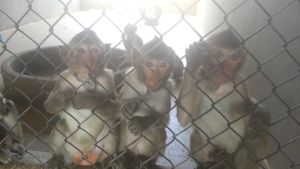
On 28th October 2021, hundreds of monkeys arrived as cargo at Chicago O'Hare International Airport in the US on an AirBridgeCargo aircraft, after being subjected to an extremely long and circuitous journey from Cambodia via Moscow and Amsterdam. The total journey time in the air was around 24 hours, plus the additional hours spent on the ground prior to departure from Cambodia, the two stopovers en route with one change of aircraft at Moscow, and the final part of the journey to the laboratory in Texas.
According to our source at Moscow Sheremetyevo International Airport and AWB 58027337015, the monkeys arrived on 27th October on Flight VD5310 from Phnom Penh International Airport, before being transferred to flight RU325. The monkeys were then flown from Moscow to Amsterdam and then to Chicago on flight RU401, arriving in the early hours on 28th October. We have been told that the final destination is Charles River Laboratories in Houston, a large US importer and user of non-human primates in research and testing. The trauma and stress these intelligent and sentient beings must have experienced, packed into small crates and travelling as cargo, is unimaginable. This would have been a gruelling and frightening ordeal for them, having to endure many hours of confinement, loud and unfamiliar noises and a huge disparity in temperature from between 22°C to 31°C in Cambodia to between 3°C and 8°C in Moscow.
Cambodia is a major supplier of long-tailed macaques for research, and every year exports many thousands of animals to the USA. The monkeys are held in industrial-scale commercial breeding facilities. Imprisoned in their thousands in concrete pens, they are denied their freedom and the lush foliage of their jungle homes, often just a few metres from their prisons.
As a result of widespread global public concern, many of the world's leading airlines that once were major transporters of monkeys to laboratories – including American Airlines, British Airways, United Airlines, South African Airways, Air China, China Airlines, Delta Airlines, Eva Air and Air Canada – ended their involvement in this cruel business. Many other passenger airlines and cargo companies have also declared their intent to not become involved in this trade in lives.
Please join Action for Primates, One Voice and Animal Rights in our call to stop these cargoes of misery. Send E-mail to AirBridgeCargo and the Volga-Dnepr Group, urging the company to stop transporting non-human primates and to join the many other airlines that refuse to play a role in this cruel trade:
25 October 2021: Appalling waste of life, 18 infant baboons killed in experiment in Kenya
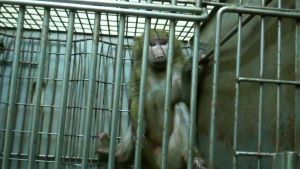
In a shocking disregard for the lives of non-human primates indigenous to Kenya, researchers killed 18 infant baboons aged between 12 and 16 months. The work was carried out at the Institute of Primate Research in Nairobi, Kenya (1). The researchers wanted to create an animal model
of human childhood
infection by Cryptosporidium, a microscopic parasite that causes cryptosporidiosis, a diarrhoeal disease.
The 8 female and 10 male baboons were housed on their own in single cages. It was particularly cruel to deprive these highly social animals of the companionship of their mothers and others of their kind. The infants were sedated with ketamine and, using a tube forced down their throats into their stomachs, they were infected with different doses of parasite eggs. Faecal samples were taken sequentially and tested for presence of the organism and blood was also collected. Other than diarrhoea in some of the infants, there was no mention of what effect the infection had on them or whether their suffering was limited to their abjectly barren lives and loss of socialisation, the latter being a critical aspect for non-human primates in captivity.
After several weeks, these infant baboons were killed and their tissues removed for examination. Not only was there no mention of how the infants were killed, the researchers described the infants as being humanely sacrificed
.
According to the recently published paper, the research was approved by the Institute of Primate Research Scientific and Ethics Review Committee (ISERC) and the Institutional Animal Care and Use Committee (IACUC), for scientific soundness and animal welfare issues before commencement of the study
. ISERC also claims to review projects based on Replacement, Refinement and Reduction (3Rs) principles
as well as the five freedoms of animals' welfare
(2). Despite this, the researchers cited several studies on human patients that have been instrumental in diagnosing and treating this disease, calling into serious question why the baboon study was approved in the first place.
We were disappointed to learn that this research was funded by a Grand Challenges Explorations grant from the Bill & Melinda Gates Foundation [Opportunity ID OPP1160347].
Action for Primates has previously exposed the suffering of baboons used as both donor and recipient in highly disturbing womb transplantation research at the Institute of Primate Research, in which three of the baboons died immediately post-surgery, two from severe dehydration
. The facility never responded to animal welfare concerns submitted to the Director by Action for Primates.
In memory of these infant baboons, please take the following action to urge the people responsible to stop this kind of research:
References:
12 October 2021: Lemurs, the smallest non-human primate in the world, being killed in French research

The gray mouse lemur, the world's smallest non-human primate, has become a 'popular' species used in research. Tragically, their ease of breeding in captivity, their short gestation (two months) and quick maturation (one year) has meant that several laboratories around the world have established colonies of these tiny primates. In France, mouse lemurs are kept captive in a colony at the Museum National d'Histoire Naturelle (National Museum of Natural History or MNHN) in Brunoy. The colony consists of hundreds of lemurs who are descendants of wild individuals kidnapped in Madagascar decades ago.
Lemurs are being used as a 'model' for people in areas such as neuroscience research, including Alzheimer's disease. Research is also carried out to study the hibernation process of the lemur and how the species survives extreme environmental conditions. In their natural habitat, lemurs hibernate for up to seven months during the dry season when food and water are difficult to find.
In one publication, researchers referenced the work they carried out on lemurs in their discussion on the use of suspended animation or putting humans into a hibernation-like sleep for space travel (1). In another experiment that took place in France, lemurs were deliberately given a reduced-calorie diet to induce torpor bouts (a state of decreased physiological activity in an animal, usually with a reduced body temperature and metabolic rate) (2). All the lemurs were killed at the end of the research to obtain their skeletal muscles to study.
Lemurs have also been subjected to invasive brain surgery. In a project that took place in France and Switzerland, lemurs were subjected to a craniotomy (surgical removal of part of the bone from the skull to expose the brain) and a cranial window
was implanted into their skull with electrodes inserted into the brain to take recordings from the brain and eyes (3).
One method used to kill the lemurs at the end of the research is through decapitation – cutting off their heads without the use of anaesthesia – an extremely inhumane method. The RSPCA state that decapitation …is controversial because…there are uncertainties over the length of time that consciousness persists in decapitated animals and whether they experience pain.
(4)
Action for Primates is supporting the campaign by One Voice calling for an end to the use of lemurs in research in France.
What you can do to help: Please Sign and Share the One Voice petition: https://one-voice.fr/en/petitions/no-to-experiments-on-grey-mouse-lemurs.html
References:
6 October 2021: Public funds used to study widely prescribed drug on pregnant non-human primates and their unborn babies
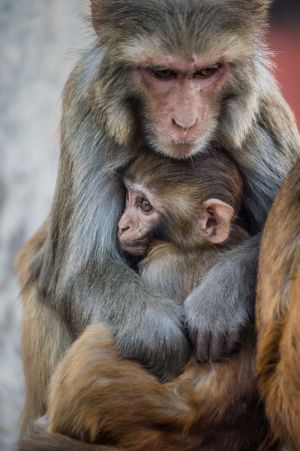
Animal researchers at the Baylor College of Medicine in the US have reportedly received almost $8 million in public funds to use pregnant non-human primates to study exposure to a drug during the development of their unborn babies (1). The aim of the research, which will be carried out at the Oregon National Primate Research Center, is to see if the diabetes drug metformin is 'safe' for use in people. This is despite the fact that metformin has been known since 1922 and was introduced as a medication in France in 1957 and the United States in 1995 (2). It is used to lower blood glucose (sugar) in patients with type 2 diabetes and is reportedly prescribed to 50 million Americans annually, including widespread use during pregnancy. It has purportedly not caused any problems in pregnant women, although there may not be enough data to be certain (3).
Pregnant female macaques, almost certainly rhesus (based on previous work by the investigators), will be given metformin or a placebo control in addition to a Western-style diet in an attempt to simulate the human situation. We do not yet know the number of individuals who will be subjected to this research or the precise protocol to be used. What will be the fate of the unborn babies? Will they be killed in the uterus and removed for examination or be allowed to be born live for studies following birth? What will happen to the mothers, especially if their babies are killed in utero or taken away from them after birth? There is no question that the macaques will be subjected to conditions unnatural for them and that some or all, including their unborn or newly born babies, will be killed to study their tissues.
This study in macaques is not only immoral, it will be scientifically contentious because there will be no way to know if the results can be extrapolated to people. Because this drug has been used in people for many decades, there is an extensive patient population that can be studied retrospectively in order to determine if there have been the types of complications to be investigated in non-human primates. Furthermore, because the drug is reportedly prescribed to 50 million Americans every year, there is no question that a well-designed prospective study in people would provide all the information needed. There is no intimation that the use of the drug will be 'put on hold' until the results of the macaque study are available many years from now. As a result, the drug will continue to be used widely while macaques suffer and die – needlessly – in the US laboratory.
This is just one more example of scientists behaving contrary to their public pronouncements that they use non-human primates (or other non-human animals) only when necessary. There is clearly no commitment to stop using non-human primates, especially because their use is far easier than working with human patients or volunteers even though such work would be far more beneficial to people in the long term.
Write to the following to express your concerns about subjecting pregnant non-human primates and their babies to the suffering involved in this research and wasting taxpayer funds:
References:
Metformin is prescribed to 50 million Americans annually, including widespread use during pregnancy. … Over the past decade, the use of metformin during pregnancy has steadily expanded beyond the treatment of overt diabetes outside of pregnancy.
Research in animals has not shown negative effects to the fetus when the mother takes the drug. However, animal studies don't always predict the way humans would respond.
19 September 2021: Evidence submitted to include animal cruelty content in proposed UK Online Safety Bill
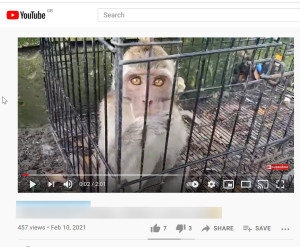
Action for Primates and Lady Freethinker have submitted evidence to a UK Parliamentary select committee established by the House of Lords and the House of Commons to scrutinise the government's forthcoming Online Safety Bill. The proposed Bill is to establish a new regulatory framework to increase accountability of online technology companies and protect users from harmful online content.
Animal abuse content disseminated online is a widespread and growing problem that involves unimaginable cruelty to animals. In our submission, which was prepared by Advocates for Animals, a UK law firm dedicated to animal protection, we argued that such content should be brought explicitly within the scope of the proposed Online Safety Bill and thereby brought within the scope of duties imposed on online technology platforms. We pointed out that self-regulation by social media platforms is not working, whether with animal abuse videos or other harmful Internet content and there is a strong need for legislation.
One example included in our submission was 'monkey hatred' videos. These despicable videos are a widespread problem on social media platforms such as YouTube. The social media platforms are responsible for online content showing shocking mistreatment and abuse of monkeys, primarily babies. There are channels on YouTube that exist solely to promote and post videos of monkey suffering, with videos showing monkeys being injured, abused or killed.
The Joint Select Committee is required to report by 10th December, at which point the Bill is then introduced to Parliament for debate.
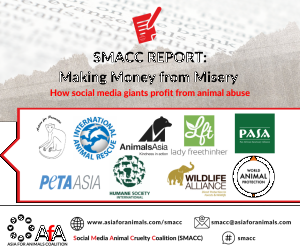
The Asia for Animals (AfA) Social Media Animal Cruelty Coalition (SMACC), of which Action for Primates and Lady Freethinker are members, has recently released a major new report – Making Money from Misery: How Social Media Giants Profit from Animal Abuse – that reveals the scope of the cruelty content problem on the largest social media platforms.
Between July 2020 and August 2021, SMACC documented 5,480 links to videos containing animal cruelty content on YouTube, Facebook and TikTok. Analysis of the data revealed that producers of these videos can become almost 'celebrity-like' with some channels boasting millions of followers. SMACC found that the total number of views of these videos alone was in the region of 5.3 billion, highlighting the scale of this somewhat unaddressed and unknown issue.
What you can do to help
13 September 2021: Baboons forced to drink vodka in addiction experiments

In this experiment, baboons were forced to become 'alcoholics' using sweetened vodka, in order to test the effects of a drug on their drinking (1). The work was done at New York State Psychiatric Institute (part of Columbia University) and …approved by the New York State Psychiatric Institute Animal Care and Use Committee.
It was funded by public funds through National Institute on Alcohol Abuse and Alcoholism (NIAAA) grant AA023879 and privately through the Christopher D. Smithers Foundation.
Four female olive baboons (Papio anubis) were used and subjected to considerable privation by being housed singly in cages. There was not even a mention of any nominal 'enrichment'. A response panel was mounted on the front wall of the home cage. The baboons had …previous experience in the self-administration of food and candy rewards…
, which means they had been coerced in some manner as part of a 'training' regimen. In order to induce alcohol drinking, the baboons were given a fruit punch solution in response to stimuli. Once they achieved a desired degree of responsiveness, alcohol (as vodka) was added to the punch, starting at a 2% concentration and eventually rising to 8% of the punch.
The baboons consumed the alcohol solutions during two daily sessions (morning and afternoon), each lasting two hours. They were allowed to drink 100 doses of 5 mL per session. This self-administration regimen using the 8% alcohol solution was maintained five days a week. The baboons had to be subjected to repeated sedation in order to draw blood to determine the concentration of alcohol.
Once the consumption of alcohol had been well-established in the baboons, they were treated with auglurant to see if this had any effect. It was found that intramuscular injection of the drug decreased alcohol self-administration, but when used orally, there was no effect. There was no description of the effects of the alcohol on the baboons – in particular, what effects were caused when the alcohol was taken away – nor was the ultimate fate of the baboons stated.
Forcing baboons to drink vodka in this research is shameful and morally reprehensible. There is enough human misery and suffering associated with alcohol consumption without deliberately inflicting the same on other sentient beings.
Further, this was a highly mechanistic approach with the intent of using the test drug to treat alcohol use disorder (AUD) in people. Essentially all the work the authors cited about this approach was on non-human animals and the authors advocated more non-human primate research. The authors made the statement, The baboon is an established animal model for drug self-administration that [sic] can be trained to self-administer alcohol, reach intoxicating blood alcohol levels during sessions, and show predictive validity in responding to medications that are effective in treating AUD…
" This is just another study in which non-human primates are being used in the vain attempt at providing a 'magic bullet' approach to dealing with AUD. This mindset, however, fails to take into consideration that AUD has little to do with the drug itself (alcohol), but more to do with genetic, environmental, socioeconomic and other issues. It is far too complex to deal with by simply 'drugging' people with medication. The NIAAA grant for this project is listed as being $418,694. Surely, better use could have been made of these resources – including the intellect and time wasted creating alcoholic baboons – if applied to helping people with AUD directly.
The New York State Psychiatric Institute (Columbia University) claims that they support the highest quality research and humane animal use
and that they are committed to using the fewest animals in research as efficiently and humanely as possible…the "3Rs"
. Action for Primates believes strongly that not only is causing baboons to become 'alcoholics' abjectly inhumane, it is scientifically and practically unnecessary as ethical studies on human patients with AUD are being done routinely, with results that will directly help those people.
Please take action to stop non-human primates being used as 'surrogates' for drug addiction research by writing to the following:
Reference:
6 September 2021: Call on UK government to end shameful support of cruel trade in wild-caught monkeys

In 2020, 25 wild-caught Guianan squirrel monkeys (Saimiri sciureus) were imported into the UK from Suriname. The details reported to CITES gave 'breeding' as the purpose for allowing the importation. It is unclear, however, if these monkeys were to be used for breeding in zoos, for the 'pet' trade or something else. Thousands of non-human primates continue to be kept as 'pets' in the UK, including squirrel monkeys and capuchins. Regardless of purpose, it is shameful that the UK government is supporting the cruel trade in wild non-human primates by granting CITES permits to allow their importation.
The capture of wild monkeys is universally recognised by official bodies and organisations as involving substantial suffering. Non-human primates are highly social animals and trapping and abducting them from their habitats, families and social groups is extremely cruel. It can also result in injuries or even death. The individuals taken will never be able to contribute to biodiversity, the local ecosystem or the genetic richness of the species.
If nothing else, the events of the past year have been a stark warning of just how fragile the environment is and the devastating impact humans are having on it and the non-human primates (and other wildlife) with whom we share this planet. Governments must protect wild populations of non-human primates and not grant any permits that allow them to be captured and traded.
Suriname and Guyana are involved in the commercial trade and export of hundreds of wild monkeys, abducted from their families in the tropical rainforests of South America. In 2019, Suriname exported 418 wild-caught monkeys, including squirrel monkeys, capuchins and tamarins.
Action for Primates supports a ban on the global trade in non-human primates regardless of source. It is urging the UK government, as a priority, to implement a ban on the importation of wild-caught primates or their offspring.
Please write to the following, urging the UK to ban importing wild-caught primates:
30 August 2021: Alarming increase in monkeys exported from Mauritius for research in 2021
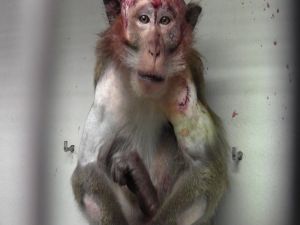
During the first six months of 2021, 7,554 long-tailed macaques were exported from Mauritius. This is more than the total number of monkeys (7,739) exported during the whole of 2019. Mauritius is a key supplier of monkeys to the US and the main supplier of monkeys to European laboratories.
Only recently, the Mauritius government gave its approval to allow the expansion of one macaque farm, Biosphere Trading Ltd, with up to 1,000 monkeys to be captured from the wild to be used for breeding. Biosphere Trading Ltd will increase its current capacity of 800 monkeys to 7,500 monkeys, with the aim of exporting 1,500 monkeys per year to the US and Canada.
A coalition of animal groups in Europe and Mauritius (Action for Primates, One Voice, Animal Rights and Progress Science Mauritius), has led an international campaign to oppose the capture, breeding and export of long-tailed macaques from Mauritius.
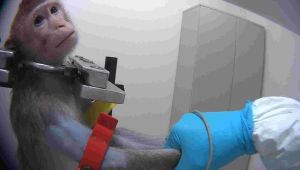
An investigation by SOKO Tierschutz and Cruelty Free International in 2014, uncovered the terrible fate for some monkeys from Mauritius, who were subjected to major surgery to have electrode chambers implanted into their skulls. They suffered from swelling, bruising and bleeding head wounds. At the end of the experiment, the monkeys were killed and their brains removed and examined.
The monkeys in this linked video were from Mauritius and were filmed inside a German laboratory. They were born in captivity on one of the Mauritius breeding farms, abducted from their families, flown to Europe by Air France where they suffered and died in the Max Planck Institute for Biological Cybernetics.
We must continue to speak out for the monkeys in Mauritius. Please contact the following and urge that protection be given to the long-tailed macaques in Mauritius in order to end their suffering for the global trade in research:
25 August 2021: Making Money from Misery: How social media giants profit from animal abuse

The Asia for Animals (AfA) Social Media Animal Cruelty Coalition (SMACC), of which Action for Primates is a member, has released a major new report – Making Money from Misery – that reveals the scope of the cruelty content problem on today's largest social media platforms.
Amid the age of mis- and dis-information in the political sphere and beyond, social media have emerged as a primary source of misleading, hateful, and often dangerous content. Sadly, non-human animals have become voiceless victims of the scramble for clicks and advertising dollars, as videos promoting, encouraging and profiting from their abuse run rampant.
Between July 2020 and August 2021, SMACC documented 5,480 individual links to videos containing animal cruelty content on YouTube, Facebook and TikTok. Analysis of the data revealed that producers of these videos can become almost 'celebrity-like' with some channels boasting millions of followers. SMACC found that the total number of views of these videos alone were in the region of 5.3 billion, highlighting the scale of this somewhat unaddressed and unknown issue.
Cruelty content takes on many forms, from the subtle and probably unintentional, to the obvious and clearly intentional. The vast majority of content that SMACC documented appears to fall into the latter category. There is footage of people eating live animals; films of infant monkeys being buried alive; kittens being stepped on or set on fire. Cruelty content is posted in order to gain recognition in the form of likes, comments or shares, or for financial remuneration. SMACC member Lady Freethinker estimated that in videos logged over three months in 2020, YouTube earned up to $12 million US from the sharing of animal cruelty content, with the content creators themselves earning nearly $15 million US. Clearly, animals are suffering for the sake of 'entertainment' and profit.
Trying to tackle this problem or even securing a dialogue with the platforms that continue to facilitate the availability of cruelty content has been difficult. SMACC is urging YouTube, Facebook, TikTok and other social media platforms where cruelty content is shared, to work with experts to clearly define animal cruelty, to create and enforce policies that do not allow the sharing of cruelty content and to develop robust monitoring systems to identify and remove such content without reliance of viewer reporting.
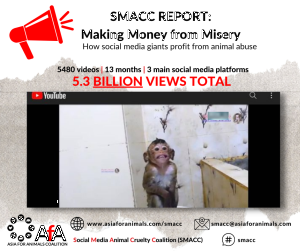
6 August 2021: 'Monkey Haters' form private group to have baby monkeys tortured and killed on camera
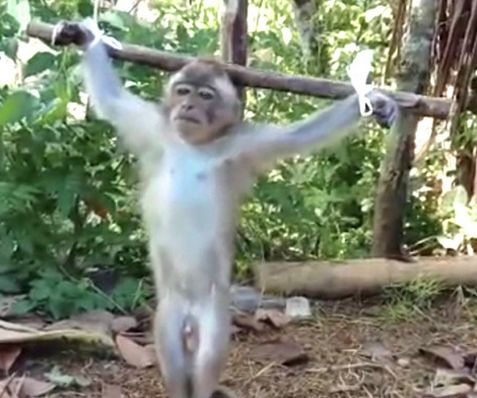
An investigation by Action for Primates and Lady Freethinker has found a disturbing escalation of animal cruelty online. YouTube and Facebook users based in the USA have set up a private online group on platforms Forumotion and Telegram, and are working with people in Indonesia to facilitate monkey torture videos. They are paying for long-tailed macaques, including infants, to be abused, tortured and killed.
The torture includes:
The monkeys are captured on the Indonesian island of Java, and the people carrying out and filming the torture and abuse receive payments. Members of the group can pay for their 'own private monkey' to be filmed while being tortured through their chosen method, or several members make smaller contributions towards a US $150 fee for their 'share' of a community monkey
, which allows members to put in requests for acts of cruelty and torture to be inflicted on this shared monkey and decide how their
monkey is to be killed.
Lady Freethinker and Action for Primates have alerted US law enforcement and Indonesian authorities and urged them to take action against this monkey torture group and its members.
We are also calling on social media and video sharing platforms to take immediate action to stop the proliferation of animal torture content that is being posted online. We have reported the relevant channels and users to YouTube, Facebook, Forumotion and Telegram, and urge these platforms to address this serious issue. Forumotion responded that they had banned the forum and its creators for violating terms of service and breaking the law and had reported them to police. The YouTube, Facebook and Telegram profiles remain active.
Dr Nedim Buyukmihci, veterinarian and co-founder of Action for Primates, stated: As a veterinarian with many decades of experience, I have never witnessed the degree of sadism I have seen in these videos. What the people are doing to these infant monkeys is particularly vile and disturbing. No responsible company should tolerate the existence of such individuals and groups on their platforms, not only because of the appalling nature of the atrocities being inflicted upon non-human primates, but also because of the alarming implications for public health.
A spokesperson for Lady Freethinker (LFT), stated: By allowing abusive channels to operate for months or even years, YouTube, Facebook, and other platforms enable animal cruelty fetishists to connect and escalate their cruel and illegal activities to sickening levels. These monkeys' suffering is real, and it is heartbreaking. Social networks can and must do better to stop animal torture for fun and profit.
This sadistic torture of monkeys is harrowing and traumatic and it is still happening now. It must be stopped. Please take action and speak out for these defenceless and innocent monkeys.
Join our appeal to the Government of Indonesia to carry out an urgent investigation to locate these sadistic individuals, to take steps to stop this extreme cruelty and to confiscate any remaining monkeys and re-home them to a sanctuary. Write to the Indonesian embassy. Sign our petition.
Dear President,
I am contacting you regarding the sadistic and disturbing monkey cruelty and torture taking place in Indonesia, exposed by the animal-protection groups Action for Primates and Lady Freethinker. A monkey hate group based in the US is paying people in Indonesia to produce monkey cruelty videos. Members may purchase their "own monkey" and pay for people in Indonesia to subject the captive monkey to depraved acts of torture and cruelty. These brutal treatments are videotaped for the member to purchase.
Examples of the torture include:
- cutting off a monkey's ear using scissors
- physically beating monkeys into submission
- throwing a monkey into a water and mud filled hole
- using knives to cut fingers off of monkeys
- using hat pins to pierce the ears, noses, tongues and eyelids of monkeys
- tying a monkey's arms behind his back followed by kicking him repeatedly in the face and forcing him under water repeatedly
- tying ('spread-eagled') infants to wooden platforms and then beating them with hands and branches
- setting a monkey on fire
- suspending monkeys by their genitals and beating them
- cutting off the arm of an infant monkey, beating infant with severed arm, then cutting throat to kill infant
I am appealing to the Government of Indonesia to carry out an urgent investigation to locate these individuals, to take steps to stop this extreme cruelty and to confiscate any remaining monkeys and re-home them to a sanctuary.
23 July 2021: More marmoset suffering at the University of Cambridge

Once again, the University of Cambridge is allowing marmosets to be subjected to considerable harm and ultimately death in the name of 'science'. The aim of this research, funded by the Medical Research Council and Wellcome Trust, was to look at the neurobiological basis of goal-directed behaviours in marmosets in an attempt to understand the causes of psychiatric disorders in human beings (1). The authors of this study stated: The projects were conducted under Home Office Project Licenses 70/7618 and P09631465…
and …regulated under the Animals (Scientific Procedures) Act 1986 Amendment Regulations 2012 following ethical review by the University of Cambridge Animal Welfare and Ethical Review Body (AWERB).
Non-human primates are purportedly provided special protections under the UK's Animals (Scientific Procedures) Act 1986.
Twelve common marmosets (Callithrix jacchus) were used, bred in-house at the University of Cambridge Marmoset Breeding Colony. Two of the females were used for tract tracing
. The remaining six females and four males were subjected to a complex behavioural training
and testing situation in a transparent Perspex box with touch-screen apparatus. Although not stated specifically, it appears that they were subjected to water restrictions because the authors used liquid reinforcements
and allowed the marmosets free access to water for two hours
after each testing session. The marmosets' diet was also restricted on testing days. Restrictions such as these are commonly used to 'motivate' non-human primates to 'cooperate'.
Once the marmosets learned the task, they were anaesthetised and subjected to craniotomy (entering the brain cavity) while held in a stereotaxic frame
, in order to implant cannulae into the brain and attach a cap
with dental cement to hold the apparatus. This was so that the marmosets could be manipulated pharmacologically – infusions of substances into various parts of their brain – while being tested. After the surgery, the monkeys were allowed to 'recover' for a week before being subjected once again to dietary restrictions and testing.
All the marmosets were killed at the end of the experiment in order to examine their brains.
Aside from the cruelty and inhumanity of treating marmosets in this way, this mechanistic research cannot provide the answers to the complex emotional, genetic and environmental stressors that cause psychiatric disorders in people. Rather, it only provided information on brain structure relative to how marmosets behaved, not people. Nevertheless, the authors concluded, self-importantly: Our findings have implications for understanding the neural control of goal-directed behavior and for certain psychiatric disorders, including OCD and schizophrenia.
There is no reason why carefully designed studies could not be done humanely using people who have been properly informed and who give their consent, something not accorded the marmosets. Not only would this provide human-relevant data, it would be consistent with the public assurance by the University of Cambridge … that the 3Rs – reduction, refinement and replacement – have been adequately applied…
to projects they review.
The University of Cambridge recently made a public announcement about the above research. Two critical issues are apparent in that announcement. One is an acknowledgement that the information gained in the marmosets can be obtained from people: Previous evidence from patients suffering brain damage, and from brain imaging in healthy volunteers, shows that part of the brain called the prefrontal cortex is involved in goal-directed behaviour.
And, while glorifying the work, they failed to mention to the public that they killed all the marmosets from whom they derived the information.
In June of this year, we reported on a protocol published by the University of Cambridge, to create a model
of anhedonia-like 'symptoms' and depression in marmosets. Anhedonia is the inability to feel pleasure from things that normally would cause pleasure. The University is promoting marmosets be used as living vehicles for testing human antidepressant drugs. Like in the case of the marmosets in the present study, that protocol calls for drilling holes through the skull in order to inject drugs while the marmosets carry out tasks inside small testing boxes.
Please send polite E-mail to the following and object to such brutal treatment of marmosets in the misguided attempt at understanding human mental health issues; clicking on an E-mail address will create a sample E-mail message, including any relevant Cc recipients, which you can then personalise:
…strongly committed to animal welfare. This means housing animals well, ensuring their environment provides them with opportunities to exhibit natural behaviours, looking after their psychological well-being, and keeping them in good physical health.
…meet the 3Rs standards
Reference:
22 July 2021: Hundreds of monkeys transported by Wamos Air from Cambodia to the USA for research
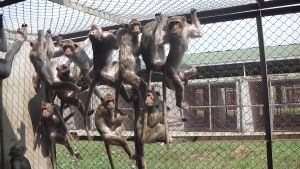
Hundreds of monkeys from Cambodia have been transported as cargo by Wamos Air, a Spanish airline, which mostly operates holiday charter flights, to Houston, Texas, via Madrid, for the US research industry. After having endured over 24 hours confined in crates on the aircraft, with many hours in transit to and from the airports and a layover in Madrid, these intelligent and sentient beings ended up at their final destination, Envigo in Texas. Envigo, a global contract testing corporation, recently submitted a proposal to expand its macaque breeding facility in Texas, with the initial aim to breed and supply up to 10,000 macaques every year to US laboratories, making it the largest breeding facility of its kind in the country.
During transportation, monkeys are packed into small wooden crates and travel as cargo on aeroplanes. In addition to the cramped conditions, they may be forced to endure inadequate ventilation, unfamiliar and loud noises, temperature and humidity fluctuations and delays en-route. Monkeys may become ill or die in transit. For others, anxiety and stress can lead to infections and the onset of disease which may remain latent until the animals reach their destination. No matter how diligent the airline is in striving to minimise the distress the animals experience, in compliance with IATA rules, it is undeniable that non-human primates will suffer in air transportation. This is because stress, distress and suffering are inherent in the process.
Please speak up for these monkeys by joining Action for Primates and One Voice in our appeal to Wamos Air and Royal Caribbean Cruises Ltd (one of the parent companies of Wamos Air) to discontinue their association with the cruel global trade in non-human primates for research. Urge Wamos Air to join the many leading airlines – including American Airlines, British Airways, United Airlines, South African Airways, Air China, China Airlines, Delta Airlines, Eva Air and Air Canada – that have ended their involvement in this cruel business, and the many other passenger airlines and cargo companies to have declared their intent to not become involved in this trade.
Contact:
2021-07-08: Young baboons given pig hearts die in gruesome xenotransplantation research

Research involving xenotransplantation – the transplantation of living cells, tissues or organs from one species to another – is some of the most gruesome work carried out on non-human animals. Such research raises many moral and welfare issues for the individuals who are genetically modified to be used as providers of organs and for those used in the research as recipients of the transplants. Xenotransplantation research involves the major trauma of the transplantation surgery and its inevitable consequences. In addition, the individuals suffer greatly from the immunosuppressive drugs they have to receive to prevent rejection of the transplanted organ, including internal haemorrhage, vomiting, diarrhoea and kidney or heart failure.
This recently published research, carried out in 2019 and 2020, took place at the Department of Surgery, University of Alabama in Birmingham (1). One of the authors is from Revivicor in Virginia, a company involved in regenerative medicine using alternative tissue sources for treatment of human degenerative disease. Revivicor provided two of the pig hearts. Despite this, there is no 'conflict of interest' statement in the publication, something that is normally required. The only financial support referenced in the article is NIH grant P40 OD024628-01 for the institution that provided the baboons (Michael E. Keeling Center). As of 2021-07-05, the amount of public funds awarded through this grant was $1,892,804.
The authors stated that the mortality rate for human infants on heart transplant wait lists …remains unacceptably high, and available mechanical circulatory support is suboptimal.
The aim of this research was …to demonstrate the feasibility of utilizing genetically engineered pig (GEP) heart as a bridge to allotransplantation by transplantation of a GEP heart in a baboon.
Four baboons about two years old were subjected to cardiac transplantation, which involves highly invasive chest surgery. Each had their hearts removed and a heart transplanted into them from pigs who were genetically modified. Those baboons who survived the surgery were treated extensively post-operatively to keep them alive and prevent rejection of the hearts.
The fate of the four baboons reveals a picture of substantial suffering and death, with two dying on the day of the surgery (the B
numbers are those assigned to the baboons by the authors):
B217died during the transplant surgery
B37367died while undergoing additional surgery for complications on the same day of the transplant surgery
B15416died unexpectedly on post-operative day 90
B1917died unexpectedly on post-operative day 241
The authors did not provide any details on how the baboons who survived the surgery behaved afterwards, so there was no information on their welfare. Incredibly, even for the two baboons who died unexpectedly
, no information was provided on how they were doing generally prior to death.
The authors made the following statement: In conclusion, survival of B15416 for 90 days and B1917 for 241 days, demonstrates a significant potential for bridging an infant to allotransplantation with a GEP heart within a decade.
The intent, it seems, is to use a pig's heart temporarily in infants while waiting for a human donor.
Action for Primates opposes xenotransplantation research and the 'creation' of genetically engineered non-human animals as living spare-parts 'warehouses' for people. Other options for addressing organ donor shortages should be considered, such as adopting an 'opt-out' approach to organ donations. In this case, unless explicitly expressed otherwise, the deceased is considered to have given tacit approval to be an organ donor.
The US, however, seems intent on adopting xenotransplantation as a solution. Not only does the country operate an opt-in system for donor donation, in 2020, the US Food and Drug Administration (FDA) approved genetically engineered pigs for use in food and medical products. The pigs sold by Revivicor can be used in the production of drugs, to provide organs and tissues for transplants, and to produce meat.
Please take action to help stop this brutal treatment of non-human primates:
Reference:
28 June 2021: Marmosets in the Netherlands subjected to inescapable electric shocks to study PTSD
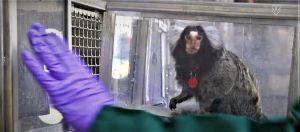
Action for Primates and Animal Right have severely criticised publicly funded research in which marmosets were subjected to inescapable electric shocks to their feet in an experiment to study post-traumatic stress disorder (PTSD) in people (1). The work was done at the Biomedical Primate Research Centre (BPRC), Rijswijk, in the Netherlands, and funded by the European Framework Program 7 (2).
PTSD is an anxiety disorder, which can develop after a traumatic, harmful or life-threatening event, such as combat exposure, an accident or physical assault. The study was done purportedly to evaluate the effect of ketamine which is used as an anaesthetic for people and other animals – on fear memory, heart rate, cortisol levels and sleep, which are affected in people suffering from PTSD.
In the recently published research, twelve adult female common marmosets were used in the research. They were placed in a passive avoidance apparatus
with two compartments (dark vs illuminated)
. Confined in one of the compartments with an electric grid floor, they were subjected to four random inescapable foot-shocks within a 15-minute period.
The marmosets were subjected to highly invasive abdominal surgery to implant a transmitter device to record sleep electroencephalogram (EEG) (recording of the electrical activity of the brain) and the heart rate by electrocardiogram (ECG). Electrode wires for the ECG were tunnelled through the subcutaneous tissue to the chest and fixed to a muscle and those for the EEG were inserted through the subcutaneous tissue to the skull and fixed by a surgical screw and dental cement.
All the marmosets were killed to study the brains.
Dr Nedim Buyukmihci, Emeritus Professor of Veterinary Medicine at the University of California, stated: Subjecting non-human primates to inescapable foot shocks in an attempt to simulate PTSD in people is a simplistic and very inhumane way of studying this distressing disorder. The general treatment hypothesis could be tested more effectively and humanely in people with PTSD. The BPRC claims it adheres to the 3Rs and
…promotes the use of alternatives to animal experiments where possible and considers their development to be part of its mission.
I believe that this study is contradictory to that.
Animal Rights founder Robert Molenaar stated: Generating so much stress, fear and pain in animals that are so much like us is nonsensical and completely unacceptable.
Action for Primates is supporting Animal Rights in its call for an end to the research at the BPRC. The Dutch government banned the use of chimpanzees at the BPRC several years ago but allowed research to continue using other non-human primates.
Please speak out for these marmosets. Sign and share this petition to the Dutch Parliament calling for the closure of the BPRC: https://www.animalrights.nl/bprc-apen-krijgen-elektrische-schokken-toegediend
References:
15 June 2021: Cambridge University publishes techniques on how to 'create' depression in marmosets

Cambridge University has developed a protocol that causes considerable harm to common marmosets (Callithrix jacchus) and is promoting this widely in the scientific community by publishing a 'how to' paper (1). The researchers describe the methodology they use to create a model
of anhedonia-like 'symptoms' and depression in marmosets. Anhedonia is the inability to feel pleasure from things that normally would cause pleasure. Blunted sensitivity to rewards is associated with anhedonia and is a core feature of depression in people. There is no evidence that any other primate species experiences this. Further, because there is no way to know what the marmosets are feeling, the researchers have to limit their claim to measuring or looking for anhedonia-like
[emphasis added] signs in the animals, not symptoms
as they incorrectly state.
To create this model
, the researchers use Pavlovian conditioning
. Once the marmosets are trained
, drugs are then injected into the regions of the brain where activity is relevant to impaired reward processing in depression in people and, the researchers claim, can be used to test the efficacy of antidepressant drugs. The marmosets are being used as living test vehicles for testing drugs for human mental health issues.
The work is being done at the Behavioural and Clinical Neuroscience Institute, University of Cambridge, and financially supported by the Medical Research Council, a publicly funded organisation, and Wellcome Trust, a charitable foundation.
The recently published paper describes the protocol the researchers use, step-by-step, starting with the training
of the marmosets to carry out certain tasks. Food rewards (non-nourishing marshmallow
sweets) are used in training
and testing. The marmosets are tested on five days out of seven each week. In order to entice
the marmosets to work, they are fed a restricted diet on testing days. The marmosets are put into a Pavlovian discrimination testing chamber
– an enclosed testing box with LED strips and audio speakers (see photos below). You can click here to see a video from the article, showing a marmoset being tested
in this chamber (be aware that the video is 87 MB and may take some time to download and display).

|

|
Marmosets are subjected to at least two major surgeries: one to implant a telemetric monitor into the abdomen via a laparotomy. This involves an incision through the abdominal wall into the abdominal cavity where the aorta is punctured to insert the telemetry probe catheter. The other surgery is to implant intracerebral cannulae to target different areas of the brain with drugs. The anaesthetised marmoset is placed in a stereotaxic frame (see photo) and the head is fixed rigidly in place, using bars in the ears, eyes and mouth. The skin of the head is cut and the skull exposed. A dental drill is used to drill holes through the skull and into the brain cavity. The protective lining of the brain (dura mater) is removed with a needle and cannulae inserted into the brain tissue. A mount for access to the cannulae is attached to the skull using dental adhesive.

Researchers claim that infusion of the drug dihydrokainic acid into a specific area in the marmoset brain results in over-activity in this area sufficient to blunt the anticipatory arousal to reward. They claim this is evidence for the correlative findings in humans that over-activity in this region (identified using functional neuroimaging in people) is associated with blunted reward responsivity seen in anhedonia and depression.
The complex emotional, genetic and environmental stressors that cause mental illness and depression in people cannot be compared with the simplistic marmoset model
created by these researchers. Further, it is clear from the authors' own statements that the issues can be – and have been – studied in people and that there are serious limitations
in the marmoset, including:
…marmosets are sensitive and temperamental animals whose behavior is sensitive to slight changes in their social and physical environment.
…the manipulations described here are all acute intracerebral pharmacological infusions which do not fully mimic the chronic depressed state.
The authors attempt to convince the reader of their humanity towards the marmosets by describing the care they provide: Paired housing wherever possible
[emphasis added] and A spacious home cage with enrichment objects.
The authors also claim that they keep the marmosets ...in a manner that fully supports their biological and social needs.
This is incorrect given that marmosets are highly social animals, live in lush jungle habitat with an abundance of trees for climbing and nesting, and an extensive and rich variety of food. None of what the authors provide the marmosets comes even close to approximating a normal environment or providing for a normal lifestyle that ensures the maximum opportunities for well-being.

supporting "biological and social needs" |
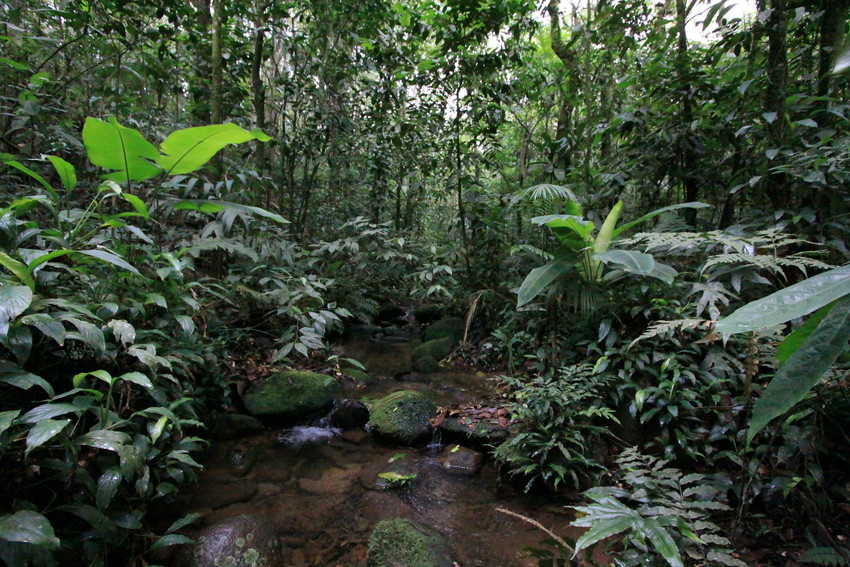
World Land Trust |
The University of Cambridge claims We place good welfare at the centre of all our animal research and aim to meet the highest standards…
. It is claimed that their Animal Welfare and Ethical Review Body …scrutinises research projects and procedures involving the use of live animals to ensure that the 3Rs – reduction, refinement and replacement – have been adequately applied and retrospectively review research projects with this in mind. This committee is proactive in the promotion of a culture of 3Rs within the University community, ensuring effective experimental design, and promotes awareness of alternatives where available.
Action for Primates believes strongly that the marmoset project is completely inconsistent with these claims.
Please send polite E-mail to the following and object to treating marmosets as living test vehicles for testing drugs for human mental health issues; clicking on an E-mail address will create a sample E-mail message, including any relevant Cc recipients, which you can then personalise:
…strongly committed to animal welfare. This means housing animals well, ensuring their environment provides them with opportunities to exhibit natural behaviours, looking after their psychological well-being, and keeping them in good physical health.
…meet the 3Rs standards
Reference:
This is an open access article under the CC BY-NC-ND license.
3 June 2021: Squirrel monkeys used in opioid addiction research in attempt to simulate human behaviour
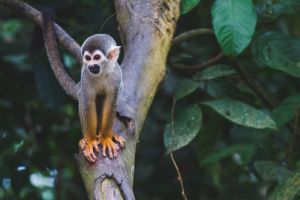
This experiment was one more in a never-ending attempt to use non-human primates as surrogates for human drug addiction. In this case, it was done in the hopes of developing a squirrel monkey 'model' of economic choice in an attempt to understand drug reinforcement, searching for improved addiction therapies for humans. Economic choice is defined as the behaviour observed when individuals make choices solely based on subjective preferences. In this research, the choice for the squirrel monkeys was between remifentanil, a short-acting opioid drug, and a palatable food reward, diluted sweetened condensed milk.
This recently published work was done at the National Institute on Drug Abuse (NIDA, a branch of the NIH), Baltimore, Maryland, and funded entirely by public funds through NIDA (1). It was approved by the Institutional Animal Care and Use Committee of the NIDA Intramural Research Program.
Ten adult male common squirrel monkeys (Guianan squirrel monkey) were used, caged individually. They were subjected to experimental sessions carried out over five days per week. During these sessions, they were confined in custom-built acrylic chairs
enclosed within a chamber and facing a touchscreen. A syringe pump was used to provide sweetened condensed milk to a drinking well positioned directly beneath the touchscreen. See photo for schematic.
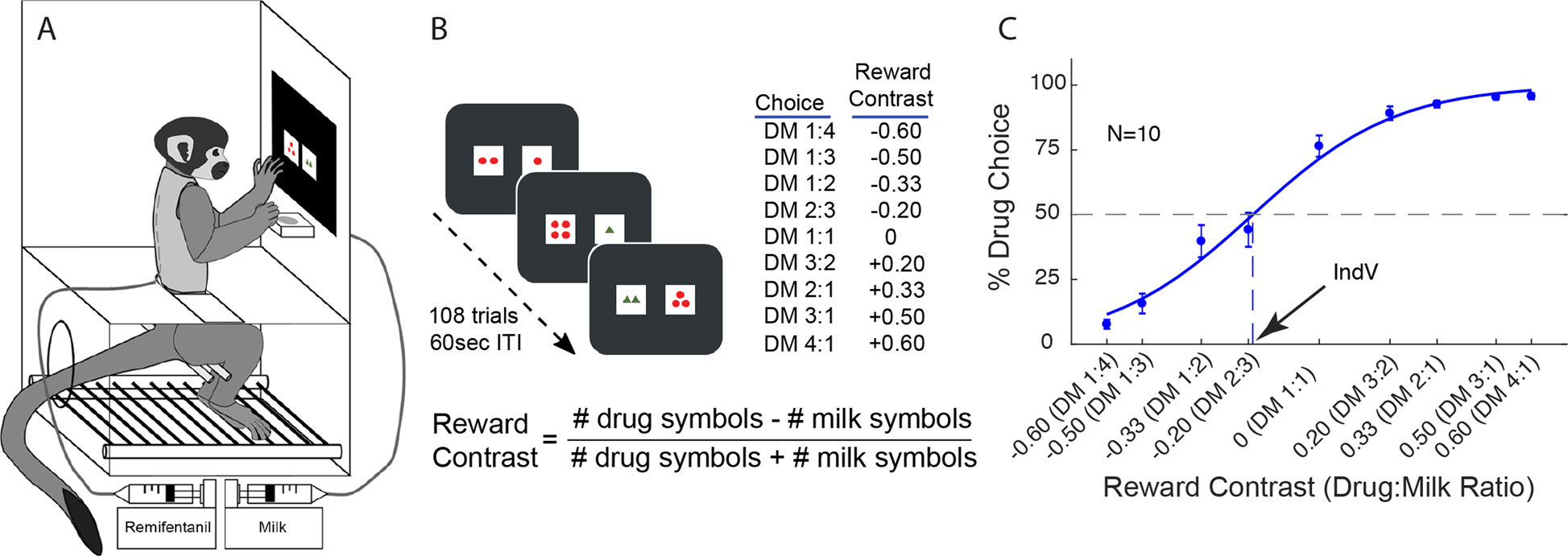
For touchscreen training
, the monkeys were rewarded with milk. They had to choose correctly to get a larger reward. Once trained
, the monkeys were anaesthetised and a catheter was surgically implanted in a jugular (neck) or femoral (leg) vein, tunnelled under the skin and exited through the animal's back. An external syringe pump was used to deliver the opioid remifentanil intravenously. After at least one week of recovery, the training
of the monkeys with remifentanil began. The monkeys had to wear jackets
or else they would try to remove these uncomfortable foreign objects implanted into them. Testing involved the touchscreen and the effect of remifentanil on their success
. Trials numbered in the hundreds. The monkeys were also injected with other drugs – morphine and naltrexone (an opioid antagonist) – to see the impact on their subsequent choice between remifentanil and milk.
No information was provided as to how many weeks or months this experiment continued, the effect of the opioid drug on the monkeys in terms of their general behaviour or well-being or the impact on the monkeys when the remifentanil was taken away. Nor was the ultimate fate of the monkeys stated.
This is yet one more example in a shocking and continuing series of publicly-funded cruel experiments in which non-human primates are forced into addiction research in the misguided notion that this will somehow provide answers and therapies for addiction in people. Drug addiction, however, is a disease in people with no counterpart in any other species. It involves considerably more than simply choosing between an opioid and sweetened milk. The authors of the paper described human economic choice as A behavioral approach with real-world parallels is one in which the consumption of drugs comes at the expense of alternative nondrug rewards, given that the choice to use drugs can result in the loss of a job, good family relations, and/or good health...
They went on to cite human laboratory studies in which ...cocaine users choose sufficiently high monetary rewards over the option to self-administer cocaine [4], demonstrating that drug users are able to minimize their drug intake when behavioral alternatives are available.
It is clear that we already know what is needed to help people, through humane studies in which people can give their informed consent, something not possible with the monkeys!
It is reprehensible that non-human primates – who cannot give their consent and are unquestionably unwilling – should be manipulated and made to suffer in this kind of 'research'. Human variables such as genetics, emotional and personal experiences, and socioeconomic aspects, can never be simulated or resolved through non-human primate research. The millions of tax dollars spent each year on 'animal models' of drug addiction could be better used to directly help the millions of people who suffer from substance abuse.
When Action for Primates pointed out the welfare and scientific shortcomings of this type of research in a previous letter to NIDA, they, disappointingly, responded with clichéd comments about the issue (personal communication, 24 May 2021):
...animal welfare is of the utmost concern...
Reviewers examine the justification for using animals in each study, whether the research goals can be accomplished using an alternative model...
...committed to ensuring the welfare of animals used in research...
...NIDA will continue to support animal research conducted in accordance with the highest scientific and ethical principles.
Please speak out on behalf of these squirrel monkeys. Send E-mail to the following individuals urging them to stop approving, funding or publishing drug addiction experiments on non-human primates. Clicking on each E-mail address will prepare a sample message containing essential information for the recipient:
Reference:
This article is licensed under a Creative Commons Attribution 4.0 International License.
14 May 2021: Legislation to end the keeping of non-human primates as 'pets' introduced in USA
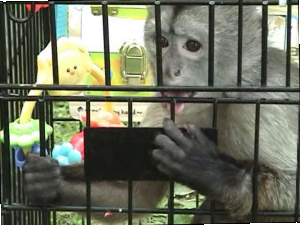
Action for Primates has welcomed the reintroduction in Congress of the Captive Primate Safety Act in the US by Representative Earl Blumenauer (D-OR), Representative Brian Fitzpatrick (R-PA) and Senator Richard Blumenthal (D-CT). Introduced this week, this new bipartisan legislation would ban the private 'ownership' of all non-human primates as 'pets', and restrict the public having direct contact with non-human primates. Click here for the Congress.gov link and here for the bill language.
In the US, the private 'ownership' of non-human primates is still legal in many states. These animals are bred commercially to be sold as 'pets'; infants are removed from their mothers and advertised for sale dressed in human children's clothes. They may even have their tails removed to make it easier to put on diapers. Non-human primates are wild animals and do not belong in captivity in homes and backyards. They should be living freely with their family and social groups in their native habitat. Depriving them of their freedom, the companionship of others of their kind and keeping them under totally unnatural conditions, is cruel and immoral.
When kept in captivity as 'pets', non-human primates can become a danger to people. As they mature and become physically stronger, they become unpredictable and aggressive towards humans and can cause serious injuries. To deal with this aggression, people will often add to the inhumanity of the situation by removing teeth and nails in the erroneous belief that this will prevent injuries.
You can find more information on the issue of non-human primates in private homes on our Non-human Primates in Private Homes ('Pets') page.
This is a critical piece of legislation and the fact that it has bipartisan support is monumental. If you are a US citizen, please contact your federal legislators and politely urge them to support this bill. We need to show Congress that the public do not want to continue the vile practice of imprisoning non-human primates as 'pets'.
Suggested message to send:
Subject: Captive Primate Safety Act
Dear [name of legislator],
As one of your constituents, I urge you to support H.R. 3135, also known as the Captive Primate Safety Act. Keeping non-human primates as 'pets' in private homes is not only cruel for the animals, it is highly dangerous for the public. The news media have reported numerous cases of non-human primate 'pets' who have become aggressive and seriously injured not only their 'owners', but also other members of the public. It is not the fault of these animals, however, it is the result of keeping them in captivity, something against which they understandably rebel.
Please express your humanity and concern for public health and support the Captive Primate Safety Act!
12 May 2021: Green monkeys deliberately wounded to evaluate human tissue graft
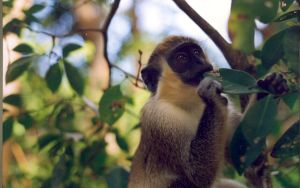
Green monkeys have lived freely on St Kitts for hundreds of years. Tragically, many of them are exported every year for research primarily to the USA, including individuals captured in the wild. Others are used in research on St Kitts itself. This research took place at the Behavioral Sciences Foundation (1).
Eighteen green monkeys were used in this research to evaluate acellular dermal matrices (ADMs). Acellular dermal matrices are derived from human skin and used in soft tissue reconstructive surgeries as scaffolds to support tissue regeneration. Two already established ADMs were used: SimpliDerm and AlloDerm RTU. Each graft was surgically implanted into nine monkeys. The animals were kept outdoors in individual cages, about 2.5 feet wide, 2.5 feet deep and 3.5 feet high.
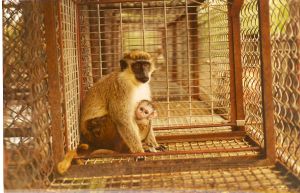
During the surgery, an incision was made into the abdomen of the monkeys and all the tissue in the area was removed to create a 3 cm x 7 cm hole into the abdominal cavity. The graft was implanted and the skin and subcutaneous tissue were sutured closed over the wound. Pain relief after the surgery was apparently only provided if a monkey showed ...signs of pain...
The authors apparently are unaware that non-human primates, including green monkeys specifically, may instinctively mask any signs of pain as a means of protecting themselves from predators or to keep social rank, even in a laboratory setting.
Clinical observations were carried out looking for incisional hernia, hematoma or seroma, as well as any gross abnormalities in general condition, appearance, appetite, stool and urine production, activity level and behavior.
No information, however, was provided on the effects of the surgery on the individual monkeys in terms of behaviour, poor health etc. The monkeys were killed at either two, four or 12 week time points and the graft and surrounding tissues were removed from their bodies and examined.
The researchers concluded that the results indicated SimpliDerm was able to promote productive tissue repair and regeneration within three months, and that their work ...may provide important insight into the potential human response to these hADM scaffolds.
[emphasis added] But, far from being a definitive study, the researchers stated that ... further studies are necessary to fully realize the clinical utility of this novel hADM.
All the researchers are or were employees of Aziyo Biologics, Inc., the producer of the tested commercial product known as SimpliDerm, at the time the work was done.
There was no need to subject the green monkeys, non-consenting and unwilling beings, to highly invasive surgery, the substantial pain of postoperative recovery and reaction to the wound and implant, and then death. Human acellular dermal matrices are already being used in human patients, as cited by the researchers who used and killed the green monkeys, and there is at least one ongoing clinical trial sponsored by Aziyo Biologics.
Although the researchers stated that this project was approved by the Institutional Animal Care and Use Committee of the Behavioral Sciences Foundation, St Kitts, we could not find any information about who to contact to voice our concerns or to get more information. We ask that you contact the Prime Minister of St. Kitts & Nevis and copy your message to those involved in tourism so that they are aware of the negative impact the capture, export, use in research and killing of the monkeys who live on the island has on the international reputation of St Kitts.
Reference:
This is an open-access article distributed under the terms of the Creative Commons Attribution-Non Commercial-No Derivatives License 4.0 (CCBY-NC-ND).
7 May 2021: Monkeys forced to become binge drinkers and cocaine users
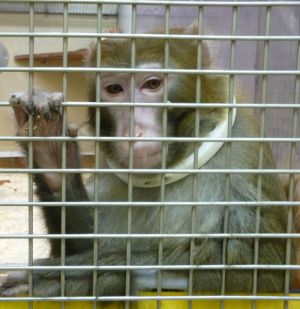
Twelve adult male rhesus macaques were used in this research carried out at Wake Forest School of Medicine, North Carolina, US (1), which was approved by the Animal Care and Use Committee of Wake Forest University and funded entirely with public funds via National Institute on Drug Abuse (NIDA; a branch of the NIH) grant DA039953.
The rhesus macaques were used in an attempt to determine whether alcohol causes more sensitivity to cocaine, as if this might answer the same question in people who abuse both drugs. To prepare them for this ordeal, the macaques were subjected to surgery to keep a catheter permanently inside a vein so that they could self-administer the cocaine. They were also fitted with an aluminium collar and restrained in an apparatus euphemistically referred to as a primate chair
, produced by Primate Products (see photo for example of one of their 'primate chairs').

Six of the macaques were coerced to drink ethanol (alcohol). A solution of 4% (w/v) ethanol in 5% Tang® was given to them via an 800-mL drinking bottle attached to each individual's cage for one hour per day, five days per week. By 18 days, the macaques ...drank enough to equal an intake of 2.0 g/kg ethanol during the one-hour period
, the equivalent of eight drinks. The researchers called this a binge-like pattern
, and continued this five days a week for about nine months before the start of cocaine self-administration. The other six macaques – the control group
– were treated exactly the same except that Tang® solution did not contain ethanol.
The cocaine-self administration began with the macaques restrained in the apparatus inside a sound-attenuating chamber. For five mornings per week, they were rewarded with banana-flavoured food pellets if they responded 'correctly' to a specific stimulus. Once a macaque reliably responded and received 30 pellets in a session (which lasted up to an hour), the catheter was implanted. Cocaine was then infused into the bloodstream and testing, in the apparatus, including food rewards, was done to see what effect the cocaine had. The macaques continued to drink an ethanol (alcohol) solution every day after they were returned to their cages.
The researchers did not say anything about the ultimate fate of the macaques, including what happened when the alcohol and cocaine was presumably taken away at the end of the research.
This project is just one more in a continuing series of publicly-funded projects in which non-human primates are forced to consume addictive substances by coercion, in the misguided notion that this will somehow provide answers to substance abuse in people. Drug addiction in people, however, involves considerably more than simply abusing certain substances. The complex combination of factors at play, such as genetics, emotional and personal experiences, and socioeconomic aspects, can never be simulated or resolved through non-human primate research. The millions of tax dollars squandered each year on 'animal models' of drug addition could be better used to directly help the millions of people who suffer from substance abuse.
Please speak out on behalf of these abused rhesus macaques. Send E-mail to the following individuals urging them to stop approving, funding or publishing drug addiction experiments on non-human primates; clicking on each E-mail address will prepare a sample message containing essential information for the recipient:
Reference:
6 May 2021: Spanish airline flies monkeys from Mauritius to the USA for research

Action for Primates and One Voice have received a tip off regarding yet another monkey shipment from Mauritius to the USA. According to our source in Mauritius, aircraft EC-NCK flew from Madrid to Mauritius and then back to Madrid before flying on to Houston in Texas, landing on the 27th April. EC-NCK is an aircraft owned by Wamos Air, a Spanish airline formerly called Pullmantur Air. Wamos Air primarily operates passenger charter flights to holiday destinations, including in the Caribbean. It also operates flights for other airlines and offers cargo-only flights.
There has been an alarming increase in the Mauritius trade in monkeys for research. In 2020, almost 11,000 long-tailed macaques were exported; a 40% increase over the previous year. This is likely to increase even further following the recent approval by the Mauritius government for the expansion of Biosphere Trading, one of the many monkey farms on the island. The company is to expand its capacity of 800 monkeys to 7,500 and will capture up to 1,000 monkeys from the wild to use for breeding purposes.
This cruel and inhumane trade involves tearing these intelligent and sensitive beings away from their family and social groups, imprisoning them on their own in small transit crates and shipping them overseas as cargo on aeroplane. We know that this is a terrifying and traumatic ordeal for them, but what they face at the end of this nightmare journey is the research or testing laboratory – unimaginable suffering and certain death.
The long-tailed macaque is the most widely used non-human primate in experiments and toxicity (poisoning) tests in contract research laboratories. Toxicity testing is carried out to assess adverse reactions to drugs or chemicals, primarily for the purpose of developing products for humans. The monkeys are restrained and the drugs may be injected intravenously (into the bloodstream) or subcutaneously (under the skin) or through a tube that is forced into their mouths to reach the stomach, or through inhalation where the monkeys are forced to inhale the substance into their lungs. Such tests involve immense suffering and can result in vomiting, seizures, weight loss, internal bleeding or organ failure. If the monkeys survive this, they are almost always killed and their bodies dissected.
Please speak out for these monkeys and join Action for Primates and One Voice in our call to Wamos Air. Please send polite E-mail urging Wamos Air to end their involvement in the cruel trade in monkeys' lives, whether through direct transportation or by leasing its aircraft to other companies:
perform support actions for different social causes. Let them know that stopping the barbaric trade in monkeys' lives is a critical social cause.
26 April 2021: Purposeful poisoning with cyanide – no limits to inhumane treatment of non-human primates in the name of 'research'
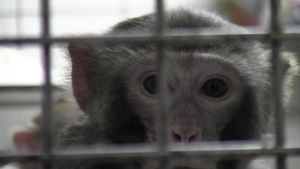
NOTE WELL: as a result of a formal complaint by Action for Primates, and at the request of the Editors-in-Chief, the publisher retracted the article from publication:
This article has been retracted: please see Elsevier Policy on Article Withdrawal (http://www.elsevier.com/locate/withdrawalpolicy).
This article has been retracted at the request of the Editors-in-Chief as the authors were unable to provide documentation of approval for the interinstitutional assurance /vertebrate animal section of the paper by the relevant authority, Public Health Service (PHS) Office of Laboratory Animal Welfare (OLAW) in the time that was provided.
The work was carried out at Charles River in Canada, but involved researchers from Southwest Research Institute in Texas, Emergent BioSolutions in Maryland and the US Department of Health and Human Services (1). It was approved by the Office of Laboratory Animal Welfare/Vertebrate Animal Section (OLAW/VAS) in the US, and publicly funded in whole or in part by the Department of Health and Human Services. It was also approved by the Canadian Council on Animal Care, who claim that they ensure ...humane treatment...
of animals.
Cyanide is one of the most lethal poisons known and death can occur within minutes following exposure (2). According to this recently published research, the objective was to demonstrate the effectiveness of isoamyl nitrite, a cyanide antidote, against lethal potassium cyanide given intravenously in conscious non-human primates. This is despite the fact that amyl nitrite has been used as a cyanide antidote in people for decades.
Twenty-two rhesus macaques were used (11 females, 11 males). They were anaesthetised and subjected to major surgery to have telemetry devices implanted into the abdominal cavity to monitor cardiovascular and lung functions; a pressure catheter implanted into the femoral artery; electrocardiography (ECG) leads implanted into the jugular vein to the heart and diaphragm; a pressure catheter implanted into the left ventricle of the heart and respiratory function leads implanted inside the animals, near the seventh rib.
Following recovery from this surgery, the conscious macaques were placed on a sling and given potassium cyanide intravenously. Some individuals were then treated with intranasal isoamyl nitrite at different doses and different times. The others were not treated with the isoamyl nitrite. According to the researchers, the ...monkeys were monitored for survival, clinical signs, respiratory and cardiovascular changes via continuous telemetry recording.

Shortly after the injection of potassium cyanide, all monkeys showed clinical signs ...leading to a serious deteriorating condition or death.
Within three minutes, the macaques had salivation, drooping of eyelids (ptosis), agitation, decreased activity, skin paleness and vomiting. Within the next 3-4 minutes, they had difficulty breathing, were gasping, their eyes were moving involuntarily (nystagmus), their pupils were dilated, they had involuntary muscle spasms and some were convulsing. For some of the animals, the antidote resulted in an improvement in clinical signs with ...complete recovery within an hour post-dose.
Those individuals who were not treated or who were treated with a low dose of isoamyl nitrite, however, continued to deteriorate until they died within 10-15 minutes of being poisoned with potassium cyanide. Two macaques ...survived the challenge, but remained lying on the cage floor without any signs of recovery...
and were killed, but not until three or five hours after treatment!
This 'research' was exceptionally appalling and barbaric. It is unquestionable that all the macaques – even those treated with the antidote – suffered substantially. In many studies in which it is known that the animals will suffer, the researchers develop guidelines to decide at what point the animals should be killed – the so-called 'humane endpoint'. The researchers in the present study, however, did not even provide for this situation. Instead, some of these macaques were allowed to die with no relief provided to ease the pain and profound suffering from cyanide poisoning. The only ones who were killed out of concern for 'humaneness' were allowed to suffer for up to five hours first.
Scientists routinely try to justify their use and killing of unquestionably non-consenting and unwilling individuals, such as the rhesus macaques in this 'study', by stating that they only do this when absolutely necessary and only to further medical benefits to people. This study, however, shows unequivocally that such pronouncements are not only untrue, there are also no moral boundaries that some scientists will not cross. Moreover, it is difficult to understand how an agency concerned with humanity – Health & Human Services – could fund such work. Even more demoralising is that the federal agency whose obligation is to ensure the humane care
and welfare
of non-human animals used in research, funded by US tax payers and comprised of veterinarians – Office of Laboratory Animal Welfare – could allow such brutal treatment of non-human primates.
Please speak out for these monkeys. Be polite, but make sure to express your outrage at this barbaric and inhumane treatment of our closest living relatives:
Reference:
21 April 2021: Safe Air to transport hundreds of monkeys from Mauritius to the USA for research
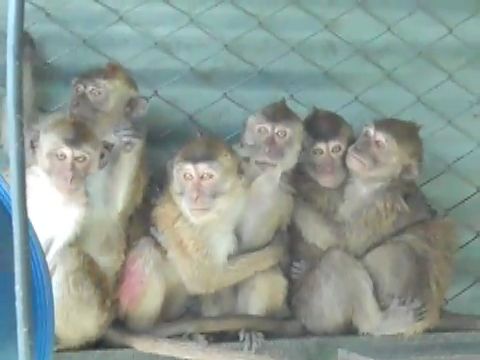
Action for Primates and One Voice have received another tip-off from our source in Mauritius that Safe Air Company (SAC) is scheduled to fly hundreds of monkeys out of Mauritius. The Kenyan-based airline has only recently started transporting monkeys from Mauritius destined for laboratories in the USA. The monkeys will be flown to Addis Ababa in Ethiopia and transferred to another flight for the trip to the USA.
The flight time will be about 20 hours plus transit time. These intelligent and sensitive animals will be subjected to unimaginable stress and anxiety as they are captured from their breeding cages, taken from their family and social groups, packed into small crates, loaded into the cargo hold and subjected to the bewildering and frightening sounds of air travel as they are transported thousands of miles across the world. Their fate in a USA research laboratory will be even worse.
This Saturday - 24th April - is World Day for Animals in Laboratories. The transportation of these monkeys is a poignant reminder of the shameful global trade in monkeys' lives, the pain and suffering they will be forced to endure and their untimely deaths in a research laboratory.
Mauritius is one of the world's largest exporters of non-human primates for the global vivisection industry. Tens of thousands of macaques are kept captive in breeding farms across the country. They spend their lives behind bars, on bare concrete, deprived of the lush foliage of their jungle home that is all around them. The Mauritius companies involved in this brutal trade ship thousands of monkeys to laboratories every year, including to the USA, Canada, France, the UK, Spain, Germany and the Netherlands.
Please join us in calling on Safe Air to refuse to transport these monkeys, and instead commit to ending all involvement with transporting non-human primates destined for research.
Send polite E-mail addressed to Mr Mohamed Aden Noor, CEO and Peter Kamile, Commercial Director, Safe Air Company (K) Limited; please send to each of the E-mail addresses below (clicking on each will prepare a blank E-mail message addressed these individuals; please use your own Subject and compose your own message for maximum effect):
19 April 2021: YouTuber in Indonesia who abused monkeys is fined and sentenced to imprisonment

Action for Primates has welcomed the conviction of a YouTuber for animal cruelty by the authorities in Jakarta. Rian Mardiansyah abused and mistreated monkeys and filmed their suffering for 'entertainment', which he then broadcasted on the YouTube channel Abang Satwa (previously called 'Monkey Raging').
The trial took place on 9th April 2021 at the Jakarta Selaten District Court Office (Kantor Pengadilan Negeri Jakarta Selaten). Mardiansyah was sentenced to a fine of Rp. 402,000 and 15 days imprisonment for behaviour relating to exploitation and violence against monkeys.
Examples of Mardiansyah's cruel behaviour towards the monkeys included spraying them with jets of water, rubbing obnoxious substances such as glue or chilli onto their food, lighting firecrackers and sparklers to scare them and encouraging the monkeys to fight each other by teasing them with food. He then posted these videos with sound tracks and commentary on his YouTube channel.
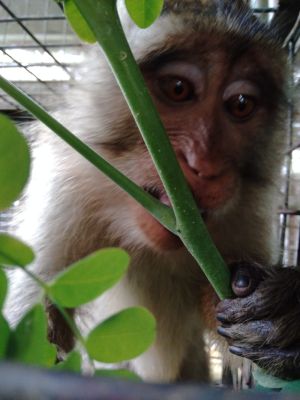
In February, Mardiansyah's monkeys were confiscated by the authorities in Jakarta, including Satpol PP South Jakarta Administrative City and the local government / pemda DKI, following complaints submitted to Dr Anies Baswedan, the Governor of Jakarta, by Action for Primates and Jakarta Animal Aid (JAAN). The three macaques – Boris, Mona and Boim – are now safely at the JAAN rescue centre and have started their new lives free from the torment and cruelty to which they were being subjected daily.
Action for Primates is grateful to Dr Anies Baswedan and the authorities in Jakarta who responded to our complaint. We hope this conviction will send an important message and help to deter other people from inflicting cruelty on monkeys and other animals in the guise of 'entertainment' for broadcast on YouTube and other social media platforms.
The conviction of Mardiansyah and confiscation of the monkeys have also shone a spotlight on YouTube and its shameful promotion of animal cruelty by allowing such abusive content to be broadcast on its platform. There has been a proliferation of such animal cruelty videos appearing online across social media platforms, including YouTube, Facebook and TikTok. The Social Media Animal Cruelty Coalition (SMACC), of which Action for Primates is a member, is playing a key role in coordinating efforts among animal welfare organisations across the world and raising awareness and educating the public. It has recently sent a letter to Mr Ganjar Pranowo, Governor of Jawa Tengah, urging the authorities to take steps to investigate other similar YouTube channels based in Indonesia. Such channels include 'Monkey Ji', whose owner also abuses and mistreats monkeys held in captivity and broadcasts their torment and suffering on YouTube.
What you can do to help stop this abuse of non-human primates and others:
14 April 2021: Monkeys suffer mutilations in deplorable spatial orientation research

Monkeys have been subjected to an appalling ordeal lasting many months during research to deliberately damage the part of their ear involved in balance (1).
The vestibular system (inner ear balance mechanism) is a sensory system that contributes to the sense of balance and spatial orientation for the purpose of coordinating movement. It works with the visual system (eyes, relevant muscles and parts of the brain) to stop objects blurring when the head moves. People with vestibular damage experience impaired vision, spatial perception and balance.
The work was done at the Massachusetts Eye and Ear Infirmary, Boston, Massachusetts (a teaching hospital of Harvard Medical School), and was approved by the Massachusetts Eye and Ear Infirmary Animal Care and Use Committee. It was publicly funded with NIH (NIDCD) grants DC008362 and DC013069, and privately with a grant from MED EL Corp, a company that produces cochlear implants for hearing issues.
Two female rhesus macaques were used, called M1
and M2
by the authors. They were ...trained to perform a psychophysical task that assayed their perception of head orientation relative to gravity...
[authors' emphasis] The 'training', which took six months, was not described, so it is not known whether the monkeys were deprived of food or liquids to 'motivate' them, as usually happens with this type of 'training'.
The monkeys were then subjected to four surgical procedures under anaesthesia:
tunneled subcutaneously to the headcap
Running wires subcutaneously under the skin to the headcap would have involved tearing a path through the tissues beneath the skin, adding to postoperative pain for the monkeys.
The researchers then attempted to carry out a vestibular ablation
, destroying the ability of the monkeys to orient themselves. Monkey M1
was injected 10 times in each ear with a drug that is toxic. Despite this, the desired loss of function did not occur, leading the researchers to conclude that Rhesus monkeys appeared to be fairly resistant to this mode of ablation, however, as ten bilateral...injections in M1 only modestly reduced...
function. The researchers then tried giving a different drug that is known to be toxic to the ear. They gave two courses of this drug intramuscularly, but this also did not result in the desired loss of function. It was not stated how frequently all these injections were made, whether M1
was awake or anaesthetised each time and what effects they had on her. Eventually, the researchers gave the original toxic drug directly into a specific part of one ear while implanting electrodes. This was also done in one ear of M2
. In both macaques, the other ear was subjected to a separate surgery: ...the contralateral ear was destroyed with a labyrinthectomy.
This resulted in ...complete loss of vestibular function on the non-implanted side and severe damage in the implanted ear...
After subjecting these monkeys to such brutal mutilation, the testing began. The researchers admitted, however, that Due to delays associated with vestibular ablation and surgical recoveries, testing in the different states was separated by substantial periods of time.
As a result, the testing took place over many months. The monkeys had to carry out the task in the dark, immobilised in a restraint apparatus with their heads further immobilised by the head bolt. They had to rotate a light bar about the roll...axis using a small steering wheel with the goal of aligning the light bar parallel to gravity.
Their eye movements were measured. Tilting the chair to see the monkeys' responses was part of the testing process.
There was no information provided on the outcome for the monkeys, their physical condition, their behaviour, how they managed in their cages following such severe disruption to their coordination and orientation. We wrote to the corresponding author of the paper and to the Editor-in-Chief of the journal and asked specifically about the fate of the monkeys. Neither provided us with this information, suggesting that they did not think it was important to include in the publication. We know that damage to a human's vestibular system can cause a person to experience symptoms such as sudden, severe vertigo (spinning/swaying sensation); dizziness; balance problems; lack of coordination; blurred or 'bouncing' vision; hearing abnormalities; anxiety; nausea and vomiting. There is nothing to suggest that monkeys do not experience the same effects. These would unquestionably be extremely frightening to a monkey who cannot understand what is happening to them and who is highly mobile and depends on their agility to survive in their environment.
This research was basic science to learn more 'details' about how balance is controlled in rhesus macaques, but may have no applicability to people. The authors stated that Considerable work remains before the VI [vestibular implant] can be optimized as a clinical therapy.
They also stated that Human implantation has been initiated by three groups...
[authors' emphasis] and that the results are promising. This calls into question, therefore, why macaques were subjected to such an arduous ordeal and mutilation. Despite this, the researchers called for more macaque research.
Please speak out as an advocate for these monkeys. The Massachusetts Eye and Ear Infirmary Animal Care and Use Committee do not provide any contact information, but Mass Eye and Ear is an integral part of Harvard Medical School. Please send a polite message urging Harvard to not approve any further research that involves this brutal use of non-human primates:
References:
It is important for all nonhuman primate researchers interested in visual information processing or operant behavior to realize that such invasive procedures [like search coil implantation] are no longer necessary.
29 March 2021: Marmosets paralysed and kept alive for up to three days for visual recordings in Australia
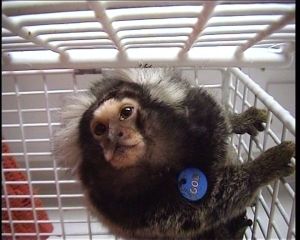
Tragically for the common marmoset (Callithrix jacchus), researchers are looking to this species as a new non-human primate 'model' to be used in neurophysiology, for visual processing and behaviour.
This research was carried out at Monash University, Australia, approved by the Monash Animal Research Platform Animal Ethics Committee and publicly funded by the Australian Research Council and by the National Health and Medical Research Council of Australia (1).
Five adult common marmosets were used (one female, four males). They were anaesthetised and subjected to invasive surgery: a tracheotomy (an incision into the windpipe), vein cannulation and craniotomy (opening up the skull) to implant electrodes into their brains. Once the surgical procedures were done, while still anaesthetised, the animals were given pancuronium bromide, which is a neuromuscular blocking agent that paralyses the animals, prevents breathing (they must be artificially ventilated) and potentially can allow them to feel pain without being able to show this by moving. The monkeys were artificially ventilated with a mixture of nitrous oxide (commonly known as laughing gas) and oxygen; there was no mention of any further anaesthetic. Recordings were made while visual stimuli were presented to the paralysed animals. The recordings went on for 2-3 days, after which the animals were killed by being given a lethal dose of sodium pentobarbital.
In addition to the inhumanity of keeping marmosets in captivity and subjecting them to research, we are concerned that, following painful surgery, the marmosets were paralysed and kept alive for up to three days. Nitrous oxide was the only anaesthetic used during this period, but it is a very weak general anaesthetic that might not have been sufficient to render the marmosets insensitive not only to the damage done by the surgeries, but also to the serious problems cause by being paralysed. It is well known that people who receive neuromuscular blocking agents for medical reasons experience a visceral reaction of extreme fear and distress even though they are being artificially respirated. They, of course, would understand that they were in no harm, something not possible in the marmosets under similar circumstances. Although it was alleged that the marmosets were continuously monitored
, because they were kept paralysed, there is no unequivocal way of knowing they did not experience fear or pain.
This experiment was basic research with no particular human benefit. The authors clearly want to continue using the marmoset as a 'model' for human brain function, as evidenced by their statement: The marmoset offers exciting new opportunities to study links between brain physiology and behavior, but the functions of frontal cortex areas are still being identified in this species. Here, we provide the first evidence of visual receptive fields in the marmoset dorsolateral frontal cortex, an important step towards future studies of visual cognitive behavior.
This does not bode well for marmosets at Monash University.
Action for Primates is working with Humane Research Australia to highlight the plight of marmosets used in cognition research carried out at Monash University. Please join us in speaking out for these monkeys.
Send polite E-mail to Professor Rebekah Brown, Vice-Provost (Research), Monash University, asking that they no longer allow experiments involving marmosets in cognition research:
For further information: https://www.humaneresearch.org.au/marmosets-paralysed-for-cognition-research-at-monash-university/
Reference:
24 March 2021: Young squirrel monkeys injected daily with marijuana (cannabis) to study teenage drug use
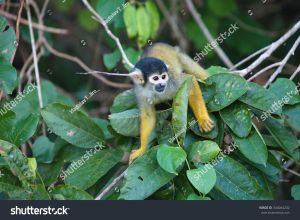
The daily use of marijuana is apparently rising in human adolescents, along with the use of high potency marijuana products such as tetrahydrocannabinol (THC). This research subjected black-capped squirrel monkeys to daily injections of cannabis for four months in an attempt to 'understand' the long-term effects of the daily consumption of a high dose of THC in adolescents and whether a therapeutic dose of cannabidiol (CBD) has a modifying effect on the THC (1).
Tetrahydrocannabinol is the psychoactive substance that produces the 'high' associated with smoking marijuana and can also lead to central nervous system depression. Cannabidiol is a major component of the active ingredients of marijuana and is used in medical marijuana.
Twelve adolescent male black-capped squirrel monkeys were used in this research carried out at McLean Hospital (part of Harvard University), with collaboration by the University of Toronto. The research was approved by the Institutional Animal Care and Use Committee at McLean Hospital and supported by public funds (NIH grant DA042178) and Harvard University.
The monkeys were divided into three groups, one of which was a 'control' group not given the drugs. The remaining monkeys were injected intramuscular daily for four months, receiving an increasing amount of either THC or a combination of THC and CBD, eventually reaching the equivalent of one marijuana joint equivalent
per day.
During the first three weeks, the monkeys underwent training
on a touchscreen. There were 90-training trials during at least five daily sessions.
During these sessions, the monkeys were held in a small Plexiglass chamber which was in a sound- and light-attenuating enclosure.

In week four, when the highest dose of drugs was injected, the monkeys were tested using the touchscreen to see the effects of the drugs on their ability to do the task. Some of the monkeys carried out hundreds of trials. The fate of the monkeys was not stated.
The authors concluded: Whether our observations are relevant to a broader range of cognitive tasks vital for daily function in humans, especially those known to be compromised by marijuana use in human adolescents (i.e., learning and memory, processing speed, complex attention, executive function, impulse control and decision-making) is uncertain. Long term marijuana use initiated during adolescence is associated with a broad spectrum of adverse effects (e.g. cognitive impairment, anxiety, psychosis, amotivation, addiction, accidents) some of which are not identifiable in laboratory housed non-human primates.
As common sense would have foretold, the authors acknowledge that the work subjecting these non-consenting beings to forced captivity, drugs and testing, may have no relevance to people. The authors also concluded that using CBD in addition to THC in the monkeys did not change the outcome.
Drug use is a major public health issue, and there is already a wealth of data on its impact. Testing could easily be carried out using morally-defensible studies in human volunteers and relevant data obtained. Despite this and while the scientific community claims repeatedly that they only use animals
when absolutely necessary
, researchers such as these continue to deliberately inflict misery and suffering by forcing drugs into non-human primates. None of these studies, however, can – nor could they ever – get to the root issues surrounding drug abuse in people, which comprise a complex combination of factors such as genetics, emotional and personal experiences, and socioeconomic issues. While millions of dollars – usually paid for by the US tax payer – are spent every year to make non-human primates 'drug addicts', people who might actually benefit from these funds and resources continue to suffer.
Please speak out for these monkeys. Send a polite message to McLean Hospital urging it to stop wasting monkeys' lives and resources by ending the cruel use of non-human primates in drug addiction research:
Reference:
20 March 2021: Export of monkeys from the Philippines for research increases seven-fold

The Philippines exported 1,053 long-tailed macaques to the USA in 2019 for research. This figure, recently made available by CITES, is more than a seven-fold increase over the number of macaques exported in 2018. The export trade in long-tailed macaques from the Philippines has been few in recent years, but the coronavirus pandemic together with trade restrictions on the export of macaques from China, the largest supplier of monkeys to the USA, has tragically resulted in an increased demand for these monkeys.
Allowing the capture of wild monkeys to be used for breeding (with their offspring exported overseas for research) is being viewed as a solution to conflicts arising between monkeys and people. Such conflicts arise primarily due to ever-increasing human expansion into and destruction of wildlife habitat. Trying to resolve these conflicts by killing or allowing the capture of wild monkeys for research is ineffective and cruel. There are humane and effective methods that can prevent problems arising and resolve conflict when it occurs.
The long-tailed macaque is now listed as vulnerable by the IUCN Red List of Threatened Species, and there are increasing concerns about the conservation status of the species, including in the Philippines. With a lack of accurate information on the macaque population in the country, we appeal to the Department of Environment and Natural Resources (DENR) not to allow the capture of macaques from the wild to supply breeding farms. Action for Primates also calls for an end to the export of these intelligent and sentient animals and the extreme suffering and death to which they will unquestionably be subjected.
There is widespread concern for the plight of the long-tailed macaque in the Philippines. Our petition (see below) has now been signed by almost 129,000 people.
Please write to the following officials below, urging the government to protect wild populations of the long-tailed macaque, to refuse any permits that would allow the capture of these monkeys and to ban the export of macaques for research.
18 March 2021: Appalling waste of life – 34 monkeys killed in ageing research
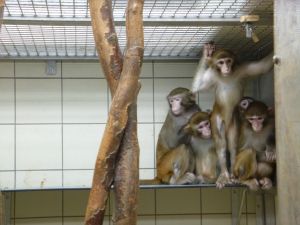
Thirty-four rhesus macaques were used and killed in this recently published research carried out at Boston University School of Medicine in the US (1). Not only was it approved by their ...Institutional Animal Use and Care Committee (IACUC)...
, it was funded entirely by public funds through the National Institutes of Health (NIH grants AG063463, AG061678, AG043640 and AG062831).
The aim of the research was to look at impairments in learning, memory, executive function, and processing speed using the research group's rhesus macaque as a model
of ageing for humans.
The macaques were between five and 30 years old and were used simply to see what changes occurred in their learning ability and their brains with age. They were subjected to a series of behavioural tests to assess learning, memory and executive functions. The testing was carried out five days a week, but for how many hours a day or how many days or weeks was unclear. When the period of testing was completed, the macaques were killed to get their brains, or in the sanitised language of the authors, the ...brains were harvested...
. The animals were anaesthetised before being bled to death.
According to the researchers, the macaques exhibit age-related cognitive impairment and can serve as a model
for studying ageing in people. These macaques, however, are essentially wild animals imprisoned in captivity. They will experience severe stresses caused by artificial experimental conditions, something that surely would have an unknown and unmeasurable impact on the their cognitive processes. From a scientific perspective, the findings in the captive macaques would have little, if any, applicability to ageing in people whose lives are fundamentally different and considerably more complex with respect to stressors. The most appropriate species to use to study people is people! More importantly, there are already data on the effects of ageing in people, as acknowledged by the authors, and more can be easily derived from humane and morally defensible studies in people.
This research comprises and exemplifies an appalling waste of life, the work obviously designed just to produce a 'library' of findings to use in future work involving rhesus macaques as a model
. It demonstrates, yet again, that the much-touted refrain of the research community of using 'animals' only when absolutely necessary is just meaningless and disingenuous.
Boston University School of Medicine claims that The humane care and involvement of animals in research is a serious responsibility shared by the entire research community.
In what way was this senseless 'research' humane
?
Please speak out in the memory of these monkeys, by sending polite E-mail to the Boston University School of Medicine, asking them to stop using non-human primates in research:
Reference:
This is an open-access article distributed under the terms of the Creative Commons Attribution License (CC BY).
9 March 2021: Secretive trade in monkeys to laboratories in Europe

Action for Primates and One Voice have shone a spotlight on the secretive world of the trade and transport of monkeys to Europe for use in research. France is one of the countries at the heart of this cruel trade. Silabe (Simian Laboratory Europe), a company based in Niederhausbergen, is a staging post known for importing hundreds of monkeys who are then moved on to laboratories across Europe.
According to information available to One Voice and Action for Primates, long-tailed macaques were transported by Air France from Mauritius and Vietnam to Silabe. From Silabe, the monkeys were shipped on to laboratories in France, including INSERM, Université de Strasbourg, CEA as well as other countries in Europe, such as Italy, Germany, and the UK. Many monkeys have ended up in contract testing facilities such as Aptuit and Accelera in Italy, Covance in Germany and Covance in the UK. Macaques from Mauritius may be very young when imported by Silabe, sometimes only 15 or 16 months old, and some may be first generation – the offspring of wild-caught parents.

Infant primates, unlike the offspring of many other mammals, have a long period of dependence and development which requires an extended period of maternal care. Under natural conditions, long-tailed macaques continue to have close contact with their mothers for several years. Females remain in their family groups for life and males remain until they are at least four years old. For infant monkeys to be taken from their mothers and family groups at such a young age and sent overseas in a crate in the cargo hold of an aeroplane must be a terrifying ordeal.
The global trade in non-human primates for research is a cruel and brutal business that is responsible for shipping tens of thousands of animals around the world. The main exporters of non-human primates to Europe are Mauritius and Vietnam. Every year, thousands of long-tailed macaques are imported to be used in experiments and testing in European laboratories.
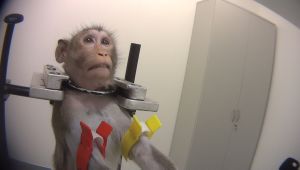
Monkeys are transported as cargo, which is an additional source of stress and suffering for them, as they are subjected to long journeys by road and air, confined in small wooden crates. From Silabe, the monkeys are sent to their final destination – the research laboratory.
Many of the macaques imported into Europe are destined to be used in toxicity (poisoning) testing in contract research laboratories. Toxicity testing is carried out to assess adverse reactions to drugs or chemicals, primarily for the purpose of developing commercial products for humans. The monkeys are restrained and the drugs are given intravenously (into the bloodstream), subcutaneously (under the skin) or through a tube that is forced into their mouths to reach the stomach. Other means of administration may include onto shaved areas of skin or by being forced to be inhaled in a chamber. Such tests involve immense suffering and can result in vomiting, seizures, weight loss, internal bleeding, organ failure and even death.
Some of the long-tailed macaques exported from Mauritius to Silabe were first generation animals – the offspring of wild-caught parents. The capture and removal of free-living non-human primates from their native habitat and social and family groups is, by its very nature, extremely cruel and results in immense suffering as well as injury and death. The European Union, in recognising the suffering involved in the capture of non-human primates from the wild, is committed to only allowing primates who are the offspring of animals who have been bred in captivity (known as F2/F2+), or who are sourced from self-sustaining colonies to be used in experiments. This requirement comes into effect in November 2022.
The continual involvement of Mauritius in the trade in wild-caught macaques is shocking. In 2020, Action for Primates and One Voice, along with other animal protection groups, launched a campaign against a controversial application by Biosphere Trading, a company in Mauritius that breeds and exports non-human primates for research. The company is seeking to expand its current capacity of 800 monkeys to 7,500 monkeys and wants to capture monkeys from the wild to use for breeding purposes.
Action for Primates and One Voice are calling for a ban on this cruel trade in monkeys' lives. Please join us by writing to the embassies of Mauritius and Vietnam.
Send E-mail to the government of Mauritius:
Send E-mail to the government of Vietnam:
Send E-mail to Air France, urging them to stop transporting non-human primates for research purposes:
Please sign and share these petitions:
2 March 2021: Oxford University and KU Leuven deliberately brain damage monkeys

Action for Primates and Animal Rights have joined forces to raise awareness about collaborative non-human primate research involving the University of Oxford in the UK and the KU Leuven in Belgium. The research, which involves macaques being deliberately brain damaged, looks at how the non-human primate brain processes, categorises and memorises visual information. It demonstrates the cruel and inhumane use of non-human primates in this area of research; the psychological and physical suffering endured by the macaques is immense.
This recently published research was carried out at the University of Oxford (1). It also involved researchers from KU Leuven as well as other UK institutions (University of Cambridge and University College London), and Canada (University of Toronto and Rotman Research Institute). The work was approved by the University of Oxford Animal Care and Ethical Review Committee and was supported by the Medical Research Council and Wellcome Trust. The stated aim of the research was to understand the neural mechanisms that support the learning of visuospatial information (a person's capacity to identify visual and spatial relationships among objects).
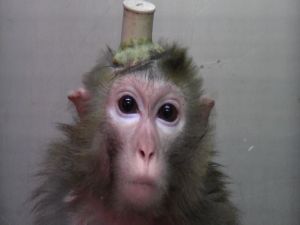
Eight male rhesus macaques were used. Four comprised the experimental
group and four the control
group. Each group was housed together. The experimental
group ...received extensive training on a complex visuospatial task for an average of 17 months to master the rapid learning of new visuospatial information during each testing session.
The method of training
was not described, but the monkeys were in a transport box fixed to the front of a large touchscreen colour monitor. Food rewards were used when an individual did the task correctly. Many trials were carried out each day, over many days.
The macaques were also subjected to surgery to deliberately damage their brains. This involved anaesthesia and a craniotomy (going through the skull to access their brains). The brain-damaged monkeys were then subjected to further behavioural testing. The brain damage had caused them to become mentally impaired and they had difficulty remembering and learning new things. The four monkeys in the control group
were subjected to surgery to have a head post implanted onto the skull, to control and force them to remain in a fixed position.
All the macaques were subjected to several magnetic resonance imaging (MRI) scans before, during and after the experiment, during which they were placed in a stereotaxic frame in the scanner.
At the end of the experiment, those monkeys who had been deliberately brain-damaged were killed by anaesthesia followed by perfusion with a fixing agent through the heart. Their brains were removed.
Oxford University ethics statement on using non-human primates in research:
On its Website, the University of Oxford provides the usual platitudes about using non-human primates in research in an effort to reassure the public that such use is humane and necessary:
The University is aware of the sensitive nature of research work that involves non-human primates... It is accepted that the use of non-human primates is likely to remain necessary for certain limited and clearly defined purposes; however, any proposal to use non-human primates will continue to receive close scrutiny in the preparation and ethical review process to determine whether the objectives could be achieved by using other species or alternative technologies. The University undertakes to reduce the use of non-human primates wherever possible to the bare minimum to achieve research outcomes and to ensure the maximum benefit to medical and research knowledge whilst ensuring the minimum cost to the animals involved.
The study we are reporting here, however, makes it clear that such a statement is completely contrary to the reality of the situation. The minimum cost
to the macaques included not only major brain surgery, but also loss of their lives! Would Oxford consider it ethical
or humane to do to humans what they regularly do to non-human primates? We have no idea what Oxford's definition of ethical
is, but it appears not to be consistent with the understanding that it means to adhere to moral principles.
Further, the authors concluded, relative to their findings, Understanding how these networks function together in the normal primate brain has the potential for earlier detection of brain changes in neurodegenerative disorders that affect reward-guided learning and memory-guided decision-making abilities and identify specific targets for more effective treatment options in the disrupted brain.
But such research is highly speculative and the findings with respect to the brain function tested can only be reliably applied to rhesus macaques. The authors also stated, Bilateral fornix damage, as predicted, significantly impaired rapid learning of new visuospatial discriminations in the monkeys.
Instead of inflicting harm and suffering on macaques, human volunteers and patients could be used in ethical studies. For example, morally defensible studies using people who have similar naturally or accidentally occurring damage could be carried out, as is done routinely in neuroscience. How does learning about a situation artificially produced in macaques, leading to information only applicable to macaques, conform to the University's assertion of bare minimum
use of non-human primates and only for maximum benefit to medical and research knowledge
?
The University also presents its work on non-human primates in a way that implies the animals are willing participants who somehow enjoy (implied by using games
and stimulating
) what they must endure:
...typically spend a couple of hours a day doing behavioural work. This is sitting in front of a computer screen doing learning and memory games for food rewards. No suffering is involved and indeed many of the primates appear to find the games stimulating. They come into the transport cage that takes them to the computer room entirely voluntarily.
This attempt at trivialising and glossing over the trauma, psychological and physical suffering endured by non-human primates is shameful and misleads the public about the inhumanity of what is being done to the animals. Non-human primates used in such brain research are held in captivity, sometimes for many years, deprived of their freedom, subjected to a 'training' regimen that may involve some control over their food or water intake to 'motivate' them to do things, purposefully brain damaged, forced to sit in front of a screen (often further restrained using a head post surgically implanted into their skull) while carrying out multiple repetitive tasks.
Please take action and speak out for these monkeys:
Animal Rights is holding a demonstration at the KU Leuven on the 4th of March 2021. Please support them by signing and sharing their Animal Rights petition:
https://www.animalrights.nl/save-ku-leuven-monkeys
Cited reference:
26 February 2021: Indonesia to allow capture and export of 2,070 monkeys for biomedical research during 2021
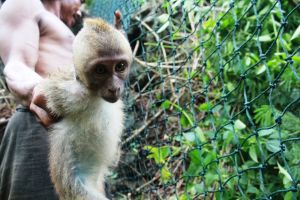
Action for Primates is appalled to learn that Indonesia is to allow the capture and export of 2,070 wild long-tailed macaques during 2021 for biomedical research. Not only is this a breach of Indonesian wildlife legislation, that was introduced in the country in 1994 and prohibited such exports of wild macaques, it is also a huge backward step at a time when there is widespread global condemnation of the trapping of wild non-human primates, especially because of the cruelty and suffering caused by the forcibly removal from their natural habitat, social and family groups.
The resumption of capturing and exporting wild long-tailed macaques by Indonesia is an alarming development. Several official bodies and organisations recognise the suffering involved in the capturing of wild non-human primates. For example, the International Primatological Society has stated:
...the capture of nonhuman primates from the wild is stressful for the animals and increases the suffering, risk of injuries, spread of disease and even death during capture, storage and transport

The European Union recognised that the capture of non-human primates from the wild is highly stressful for the animals concerned and carries an elevated risk of injury and suffering during capture and transport. In order to end the capture of animals from the wild for research, including for purposes of breeding, the European Union Directive (2010/63/EU) introduced provisions with the objective of moving towards using only non-human primates who have been bred in self-sustaining colonies, from parents who themselves have been bred in captivity. The implementation date for these new provisions has been set for 2022.
Long-tailed macaques are indigenous to Indonesia and are part of the rich and diverse ecosystem, contributing to the country's unique biodiversity. The species is listed under Appendix II on CITES (Convention on International Trade in Endangered Species of Wild Fauna and Flora). Further, there has been a new global assessment by the International Union for Conservation of Nature's (IUCN) Red List of Endangered Species for the conservation status of the long-tailed macaque. The species has now been listed as 'Vulnerable' with a decreasing population trend.
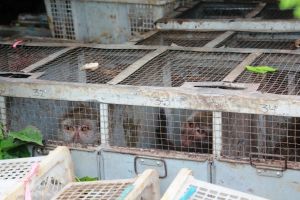
The reason often cited by authorities for allowing the capture of long-tailed macaques is that the animals are coming into 'conflict' with residents and farmers in local communities. An ever-increasing expansion and encroachment into wildlife habitat by people is the primary cause for these 'conflicts', not the fault of the macaques. Rather than allowing wild macaques to be trapped and exported for research, Action for Primates urges the authorities to resolve the issues that lead to negative interactions, such as deforestation and disposal of food waste that results in macaques being attracted to human settlements.
Please join us by calling on the Government of Indonesia to 1) stop the capture and export of long-tailed macaques, and instead to enact legislation that provides protection for this indigenous macaque population and 2) to adopt humane and preventative methods that can be used to resolve 'conflicts' without resorting to the capture and export of macaques for research.
Send polite E-mail to:
18 February 2021: Monkeys subjected to spinal cord damage in Swiss experiment*
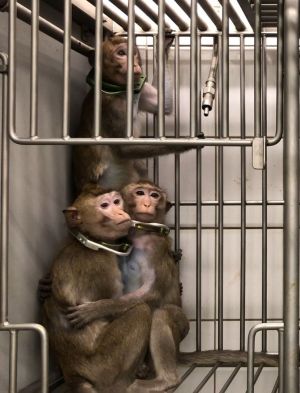
The research, published in January 2021, was carried out at the University of Fribourg in Switzerland (1). Funding was from several sources, including the European Union's Horizon 2020 research and innovation programme, and the research was approved by the local veterinary authorities of the Canton of Fribourg. The researchers declared the following Competing interests
: three were shareholders and founders of GTX medical, a company producing spinal cord stimulation technologies and who provided part of the research funding, and five were inventors of multiple patent applications and had been granted patents covering parts of this work.
Five long-tailed macaques were used and were subjected to deliberate spinal cord damage. This involved major surgery to remove parts of their vertebrae to implant spinal electrodes as well as to have muscle electrodes implanted. Electrical stimulation was then applied to parts of their spinal cord to study arm and hand movements. Three of the macaques were used in terminal
procedures and underwent electrophysiological tests. They were killed before waking up from the surgery. The other two macaques were used for acute
procedures in which they were anaesthetised, underwent electrophysiological tests and were then allowed to recover. The researchers state that one of the monkeys had been trained
(although they do not describe how) to reach, grasp and pull an object using a robotic framework designed by the researchers.
Human patients with similar spinal surgeries were also tested.
Despite the authors' assertion that All procedures were carried out in accordance to...the principle of the 3Rs...
,* essentially similar or at least clinically relevant data were obtained from people who had spinal surgery. The authors also cited numerous studies on people with spinal cord injury, studies that have resulted in considerable knowledge about spinal cord injury in people.
Please speak out for these monkeys by sending polite E-mail to the authority that approved this research. Ask them why they approved research that was scientifically unnecessary and involved deliberate mutilation and suffering in these monkeys. More importantly, urge them to stop approving the use of non-human primates, who are non-consenting and unwilling participants:
Reference:
* Readers should be aware that we report only a tiny fraction of the highly invasive and fatal research done on non-human primates. We review dozens of these publications every week.
** The 3Rs stand for Replacement, Reduction and Refinement. The goal is to replace animal experiments whenever possible, use the fewest number of animals (reduction) and minimise suffering (refinement).
8 February 2021: Monkeys subjected to multiple surgeries, demanding physical tasks pulling weights and death to study 'strength training'

The work was done at the Institute of Neuroscience, Newcastle University in the UK, approved by the Animal Welfare and Research Ethics Board of Newcastle University and funded by the Wellcome Trust and Reece Foundation (1).
The aim of the research was to compare the relative contributions of various neural pathways associated with strength (resistance) training.
Two female rhesus macaques identified as Monkeys N and L
, were used. They had been trained
to perform a strength
task using food rewards, but no further details were provided on the training process. The monkeys were then subjected to two surgeries. In the first, a skull restraint device was implanted and electrodes were implanted into muscles in their hands, arms, shoulders and chest. In the second surgery, two electrodes were implanted into the macaques' brains. Monkey L underwent a third surgery to implant another electrode into the brain in order to stimulate the reward centre to motivate
her to undertake the strength training
.
After the surgeries, the macaques underwent strength training protocols
that were done five days a week for 12-13 weeks. The animals were restrained inside a cage (see article photo of monkey in test chamber) by their head using the skull headpiece implant and a collar placed around their neck. A further restraint was attached to their left arm to prevent it from being used. A pulley system with weights was used and the monkeys had to pull on a handle, through a hole in the cage, using only their right hand. Recordings were made while the macaques did the task.

The weights were gradually increased day by day until the weights were equivalent to the macaques' own body weight. The macaques were forced to carry out 150 trials on each day.
After the 12-13 week strength training period, the monkeys continued for another three months, carrying out 20-30 trials 5 days per week. They were then subjected to further surgery, involving a craniotomy (the surgical removal of part of the bone from the skull to expose the brain) and a laminectomy (the removal of part or all of the vertebral bone to expose the spinal cord). New electrodes were inserted and the animals were kept alive under terminal anesthesia
while more recordings were made, before finally being killed and their bodies dissected.
This was pure basic science research with no clinical applicability cited, and no suggestion of treating a human disease, nor can the data be uncritically applied to people. Further, the authors admitted that, The human strength training literature has used noninvasive techniques to investigate the neural changes associated with strength gains.
There is no question that similar data, using electrocardiography, electromyography, functional magnetic resonance imaging and positron emission tomography – procedures routinely done in people for diagnostic and research purposes – could be derived from human volunteers. Instead, the researchers subjected two sentient beings to multiple surgeries and physically demanding tasks before killing them. They seemed to be proud that they ...provide the first report of a strength training intervention in nonhuman primates.
Newcastle University claims that they are ...committed to the principles of the 3Rs.
These involve Replacement, Reduction and Refinement. The University also claims a ...policy of using animals in research only if there are no realistic alternatives and in projects of major importance. UK standards of care are among the highest in the world, and we strictly enforce them.
Replacement, as defined by Newcastle University, is to use ...methods which avoid or replace the use of animals.
We believe strongly that the principle of Replacement and their stated policy were violated by this study. Sophisticated and humane methods of studying the phenomenon of strength training have been and can continue to be studied in human volunteers. There is no need for subjugating, causing to suffer and killing non-human primates.
We hope you will send polite E-mail to the Newcastle University Animal Welfare Ethical Review Board (AWERB) and express your concern for the suffering and waste of life approved by them:
Reference:
This is an open-access article distributed under the terms of the Creative Commons Attribution License Creative Commons Attribution 4.0 International.
1 February 2021: Monkeys rescued from YouTube channel animal abuser

Action for Primates is delighted that, following our work with Jakarta Animal Aid (JAAN), the three monkeys who were abused and filmed for 'entertainment' by the YouTube channel Abang Satwa (previously called 'Monkey Raging') have been confiscated by the Indonesian authorities. The three long-tailed macaques, called Boris, Monna and Boim, are now safely at the JAAN rescue centre and can begin their new life free from the torment and cruelty to which they were being subjected daily. See our News page for photos of these three individuals in their temporary quarters at JAAN.

Examples of this person's cruel behaviour towards the monkeys include spraying them with jets of water, rubbing obnoxious substances such as glue or chilli onto their food, lighting firecrackers and sparklers to scare them and encouraging the monkeys to fight each other by teasing them with food. He posts these videos with sound tracks and commentary.
We are grateful to Dr Anies Baswedan, Governor of Jakarta, Satpol PP South Jakarta Administrative City, the local government / pemda DKI and others who responded and confiscated these monkeys.
Thank you to everyone who took action and sent E-mail on behalf of these abused monkeys. Animal cruelty in the guise of 'entertainment' must never be tolerated and it is shameful that YouTube and other social media platforms continue to allow such content to be posted.
What you can do to help in this success story:
29 January 2021: Indonesia resumes export of long-tailed macaques for research purposes
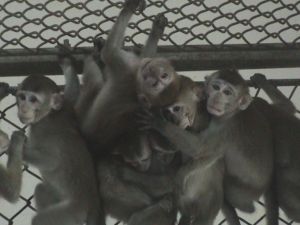
Indonesia has re-started the export of long-tailed macaques (Macaca fascicularis) to be used in experiments. According to data submitted by Indonesia to CITES (Convention on International Trade in Endangered Species of Wild Fauna and Flora), 1,500 monkeys were exported to China and 69 to Denmark during 2019. This follows a four-year period (2015-2018) when there were no exports recorded for long-tailed macaques from Indonesia. In 2017 and 2018, Indonesia recorded the export of 160 pig-tailed macaques (Macaca nemestrina) to the USA.
Action for Primates is concerned that the monkeys, reportedly exported for 'trade' purposes, were either used in research or for breeding to produce offspring to be used in research.
Long-tailed macaques are indigenous to Indonesia and are part of the rich and diverse ecosystem, contributing to the country's unique biodiversity. The species is not protected under Indonesian law, however, and can be captured from the wild by breeding companies supplying laboratories in Indonesia and elsewhere. There is also a widespread domestic trade in wild-caught long-tailed macaques to be sold at markets and into the 'pet' trade.
Long-tailed macaques are listed under Appendix II on CITES, which means they are considered vulnerable. Further, there has been a new global assessment by the International Union for Conservation of Nature's (IUCN) Red List of Endangered Species for the conservation status of the long-tailed macaque. The species has now been listed as 'Vulnerable' with a decreasing population trend. The resumption of exporting long-tailed macaques by Indonesia is an alarming development, one that will further negatively impact this species.
Please take action on behalf of the monkeys by joining our call to the Government of Indonesia to enact legislation that protects the indigenous long-tailed macaque population from exploitation for research, entertainment and the 'pet' trade.
Send polite E-mail to:
21 January 2021: US researchers involved in inescapable electric foot shocks and more to study 'depression' in monkeys
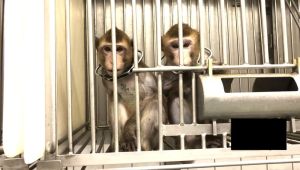
Young monkeys were deliberately subjected to extremely cruel and barbaric treatment in an attempt to simulate human teenage depression (1). Although this recently published research was done at Chongqing Medical University in China and supported mostly with Chinese funding, there are two US authors, one from Wake Forest School of Medicine and another from Virginia Commonwealth University. The work was approved by the Ethics Committee of Chongqing Medical University, but there is no mention of any oversight or decisions by ethics committees at either of the US facilities. The latter is disturbing in and of itself.
In the research, ten male adolescent long-tailed macaques, some less than two years old, were used. They were housed singly in cages. The 'experimental' group (as opposed to those serving as 'controls') were subjected to chronic unpredictable mild stress
for seven days, and then observed for four days. This cycle was repeated four more times. The stressors the monkeys were subjected to, in some cases lasting 24 hours, included:

Noise: A buzzer with a 100 decibel shrill chirp was placed in the monkeys' room for 12 hours from 8:00 PM to 8:00 AM the following day. According to the US Centers for Disease Control and Prevention (CDC) noise above just 70 decibels over a prolonged period of time may start to damage your hearing.
Water deprivation: The monkeys were deprived of water for 12 hours from 8:00 PM to 8:00 AM the following day.
Food deprivation: The monkeys were deprived of food for 24 hours from 8:00 AM to 8:00 AM the following day.
Space restriction: The cage space of the monkeys was restricted by a push-pull device for four hours from 8:00 AM to 12:00 PM.
Cold stress: The monkeys were sprayed with 10°C water for ten minutes. Although long-tailed macaques are known for their affinity for water, the natural conditions do not involve such cold water nor for such an extended period. Further, under natural conditions, the macaques emerge into a warm and usually sunny environment so that they can dry off quickly.
Exposure to stroboscope: Flashing stroboscopes were placed facing the monkey cages for 12 hours from 8:00 PM to 8:00 AM the following day. Flicker causes disturbance and can cause physiological effects such as headaches, at least in people.
Inescapable foot shocks: The monkeys were exposed to foot shocks by an electric shock stick from which they could not escape. The shock was 6 volts lasting 10-15 seconds with intervals of ten seconds. The monkeys received 3-4 rounds of this.
Two different stressors were used each day. The macaques' behaviour was observed and recorded, their weight was recorded and certain standard 'tests' were done to see the difference between 'controls' and stressed individuals. The researchers were looking for both depressive-like behaviours and anxiety-like behaviours, such as a huddle posture, self-clasping with head at or below the shoulders.
This is a shocking and damning indictment of the appalling way in which non-human primates are abused in the name of science. The mental anguish and torment these monkeys must have suffered is unimaginable. As a gesture to ethics
, the researchers provided the monkeys with an eight-hour window each day when they allowed the animals social contact with each other, toys (already scientifically proven to be of only transient value) and fruit and vegetables (apart from those of food deprivation) ...to meet experimental requirements set by the institutional animal care and use committee...
, which they admit may have influenced the outcome of the study.
The researchers were trying to establish a non-human primate 'model' for human adolescent depression, and yet their paper states that ...youth with depression experience more serious impairments in global functioning, an increased risk of tobacco smoking and other substance abuse2. Moreover, suicide is the third leading cause of death in adolescents; and among depressed youth, 29% experience suicidal thoughts and 11% attempt suicide4.
All these depressive behaviours, critical in understanding and helping troubled human adolescents, are not reproducible in non-human primates, rendering the authors' abjectly inhumane 'model' of no relevance.
The researchers stated that they were able to ...induce depressive-like and anxiety-like behaviors...
in macaques. By using such terms, however, the authors clearly acknowledge that their 'model' is only superficially similar to the situation seen in adolescent human teenagers. Despite this, the researchers conclude that subjecting macaques to chronic stress provides ...a promising model to study the mechanisms underlying adolescent depression.
No amount of artificial and cruel stressors inflicted on macaques can compare with the complex emotional, genetic and environmental stressors that cause mental illness and depression in human teenagers.
The Wake Forest School of Medicine claims that the goal of their Animal Welfare Program ...is to ensure that animals at Wake Forest are always treated ethically and humanely.
Virginia Commonwealth University states that their Animal research program places ...the ethical treatment of animals as a primary responsibility and the founding principal [sic] of our animal care and use program
and that they employ the ...ethical mandates, known as 'The Three Rs' of animal research
(Reduction, Replacement and Refinement). Did these institutions approve the involvement of their representatives in research that was not only extremely cruel, but also of no scientific merit? Would they consider the research they endorsed, albeit indirectly, to be 'humane'?
Because we were concerned that there was no oversight mentioned in the article for allowing US-based researchers to take part in this abjectly inhumane experiment, Action for Primates wrote to each institution, asking for clarification. Neither institution provided any information. It is important that these institutions are contacted, so that they can appreciate the level of concern by the public.
Please take action for these monkeys by contacting the US-based institutions and ask whether they provided any oversight on allowing their faculty to perform the above research and, if they did, how they could have approved a situation that clearly was contrary to their stated policies. Politely urge them to prohibit their researchers from participating in any future collaborative research with China involving depression research on non-human primates.
Reference:
This article is licensed under a Creative Commons Attribution 4.0 International License.
15 January 2021: Squirrel monkey tails immersed in hot water in pain research

An unknown number of male squirrel monkeys were used in this publicly funded research (NIH grants DA13429, DA039997, DA018151, DA035857 and DA047574) at the McLean Hospital/Harvard Medical School in Massachusetts, USA (1). The monkeys were subjected to what is called the tail withdrawal latency assay
to look at behaviour and the effect of opioids in blocking the detection of pain.
The monkeys had the last ten cm of their tails kept shaved of hair to provide a surface that would be more readily impacted by the hot water. They had been trained
using a fluid reward (sweetened condensed milk) and had to respond to lights to get the reward. The monkeys were restrained in Plexiglas devices with their tails hanging freely behind them. The shaved ends of their tails were immersed for up to ten seconds in water that was heated to 50°, 52° and 55° Celsius (122°, 125.6° and 131° Fahrenheit, respectively). The authors even stated that 55° Celsius was very hot
. Water at such a temperature would be painful for a person's hand, can lead to second degree burns in 17 seconds and third degree burns in 30 seconds.
The test was to see if the opioid drug the monkeys were given would alter the time before the monkeys withdrew their tails or how it would otherwise affect the response of the monkeys to the 'task' they had to perform in order to get a reward.
Squirrel monkeys (possibly the same individuals used in the hot water tail immersion tests) were also acclimated
to small, round, plastic chambers and exposed to air or a mixture of carbon dioxide (CO2) to see what effects the drug had on their breathing under these circumstances. The animals experienced respiratory depression (hypoventilation; a breathing disorder characterised by slow and ineffective breathing).
The authors stated there was no visible damage to the animals. Nevertheless, it is unquestionable that immersing the monkeys' shaved tails into very hot
water would have resulted pain. There is no information provided on the fate of the squirrel monkeys.
Please speak out for these and other monkeys being used at McLean Hospital. Send polite E-mail to voice your objection to such inhumane and pointless 'research':
Reference:
Article freely available under Creative Commons license link.
7 January 2021: Renewed call to Carlsberg Foundation to stop funding high altitude and other cruel experiments on non-human primates

Action for Primates has received a response from the Carlsberg Foundation, following our recent highlighting of the disturbing use of monkeys in high altitude research carried out in China, in which one of the authors was funded by a grant from the Carlsberg Foundation. The response did not express concern about supporting such cruel research in which the monkeys suffered substantially. Further, they stated: ...we do not have our own policy on animal experiments but always expect our grantees to abide by the rules of the institution at which the grantee is employed.
If you have not already done so, we urge you to write to the Carlsberg Foundation and politely call on it to adopt a policy and to stop funding high altitude and other cruel experiments on non-human primates. Thank you to everyone who has already written.
In the research, long-tailed macaques were subjected to hypobaric hypoxia that simulated travelling rapidly up to 7,500 metres (over four miles), which reduced the concentration of available oxygen. Hypobaric hypoxia is a condition where the body is deprived of oxygen, causing severe brain injury and abnormal behaviour. They were held at this high 'altitude' for 48 hours and then killed.
Please send polite E-mail:
Click here to see our original alert on this issue.
5 January 2021: Call for action to be taken by Jakarta police against monkey tormentor on YouTube

Sickening videos showing monkeys being cruelly treated and abused are regularly posted on YouTube channels, and other social media platforms, to 'entertain' viewers. One such YouTube channel (Abang Satwa) is based in Jakarta, Indonesia. The person who runs the channel regularly posts videos in which he torments and abuses captive monkeys he keeps imprisoned at home on chains and in small cages, while asking people to send donations via PayPal. Examples of his cruel behaviour towards the monkeys include spraying them with jets of water, rubbing obnoxious substances such as glue or chilli onto their food, lighting firecrackers and sparklers to scare them and encouraging the monkeys to fight each other by teasing them with food. He posts these videos with sound tracks and commentary. As much as the cruelty and tormenting are shocking, the supporting comments posted by viewers, with suggestions of further cruel things that can be done to the monkeys, are also disturbing.
YouTube has failed to respond to calls to block this channel. The individual running this YouTube channel was also reported to the South Jakarta police by Jakarta Animal Aid Network (JAAN). The Jakarta police have so far failed to take action, despite having previously been involved in confiscating monkeys being cruelly treated by other individuals. We are, therefore, taking our appeal to the Governor of Jakarta to urge him to take this animal cruelty seriously. Please join us in calling on the Governor to 1) confiscate these monkeys and relocate them to a genuine animal sanctuary and 2) ban the individual who runs Abang Satwa from obtaining monkeys and any other animals.
What you can do to help stop this abuse; please be polite when you E-mail these people:
2 January 2021: Monkeys killed to study effects of stress on menstrual cycles

Long-tailed macaques have been used to study the effects of stress on their reproductive function, in an attempt to simulate human female functional hypothalamic amenorrhoea (FHA). The human condition is a type of infertility – a sustained absence of normal menstrual cycles – linked to stress. The recently published work (1) was carried out at the University of Pittsburgh and approved by their Institutional Animal Care and Use Committee. It was supported entirely by public funds (NIH grants HD062864, HD62618 and OD011092).
Twenty-seven female long-tailed macaques aged between 7-13 years were imported specifically for this experiment. They were housed singly. The monkeys were exposed to a combination of stressful stimuli which involved their being moved to a new housing room, where they were surrounded by unfamiliar animals, having their diet reduced by 25% and forced to run for 30 minutes a day, 5 days a week on a motorised treadmill. The effect of test drugs on reproductive cycling during two of the 'stress cycles' was also studied. At the end of the experiment, all the macaques were killed so that their brains could be removed for further study.
Previous similar research by the authors, published in 2008, provided details on how the human size motorised treadmills (Precor Model 910e) were used. The treadmills were enclosed by a Plexiglass® box that contained holes for air. The monkeys were initially allowed to walk slowly for about one week. Then they were given a 'max' test to establish the maximum rate which they were capable of running
. The treadmill was set for the monkeys to start running at 0.8 miles/hour and speed was then increased 0.2 miles/hour every two minutes until the monkeys failed to be able to keep up with the pace of the treadmill. In this original experiment, the monkeys were forced to run one hour a day, five days a week. In the present experiment, however, the monkeys were forced to run for less time each day ...because several treadmills broke (beyond repair) and no funds were available for the purchase of new treadmills.
Deliberately treating non-human primates as disposable 'things' by placing them in these stressful situations – including forcing them to run on treadmills, depriving them of food, scaring them with strangers and then killing them – is any rational person's definition of cruel treatment. It is not only morally unconscionable, it is also a clear contradiction to the three Rs the research community claim they follow: Replacement, Reduction and Refinement. The issue of reproductive disorders in people has been and is continuing to be studied in people, providing the only source of information directly applicable to people.
Please speak out for the monkeys, by sending polite E-mail to the University of Pittsburgh Institutional Animal Care and Use Committee (Animal Research Protections) which ...oversees the university's animal programs, facilities, and procedures insuring the appropriate care, use, and humane treatments of animals being used for research, testing, and education
, urging it to stop approving this research:
Reference:
You can find out more information on all grants made by the National Institutes of Health, the largest funding entity in the US, and all their agencies by using the NIH RePORTER. You can search by grant number, investigator, recipient institution and more (see instructions).
![]()
![]()
![]()
![]()
![]()
Contact us via E-mail
Copyright © 2020-2026 Action for Primates. All rights reserved.